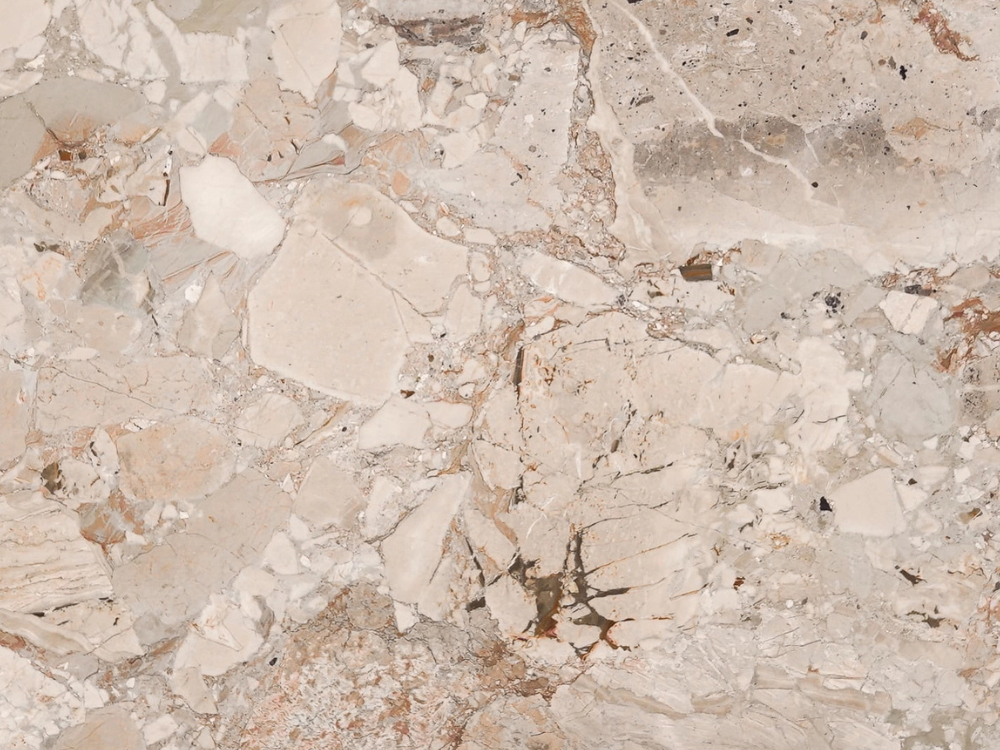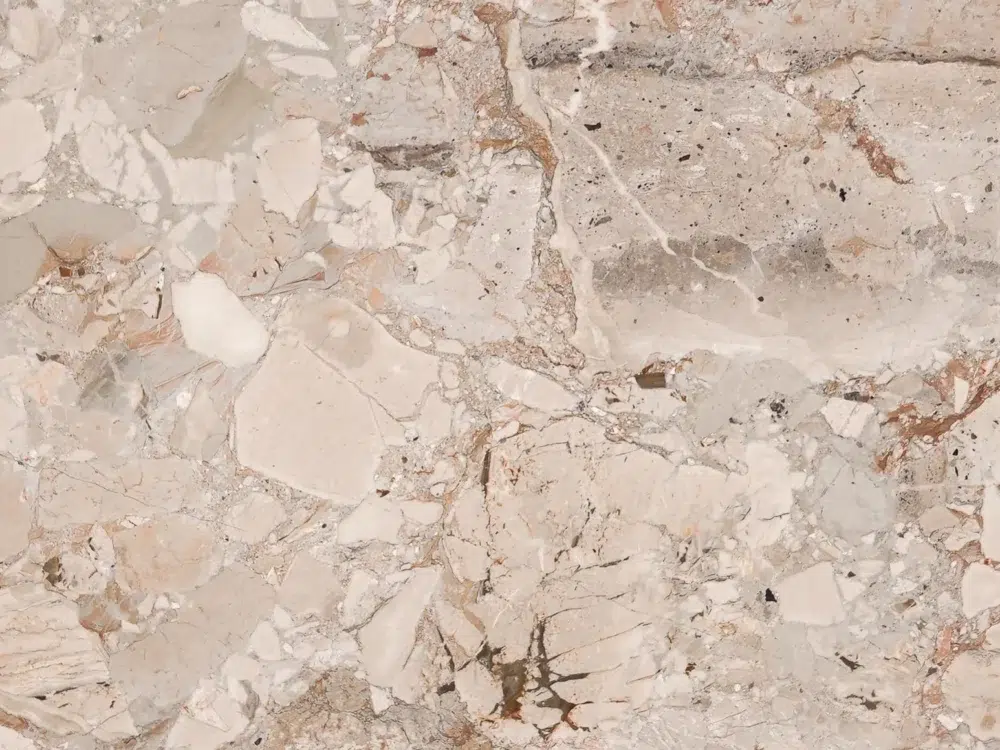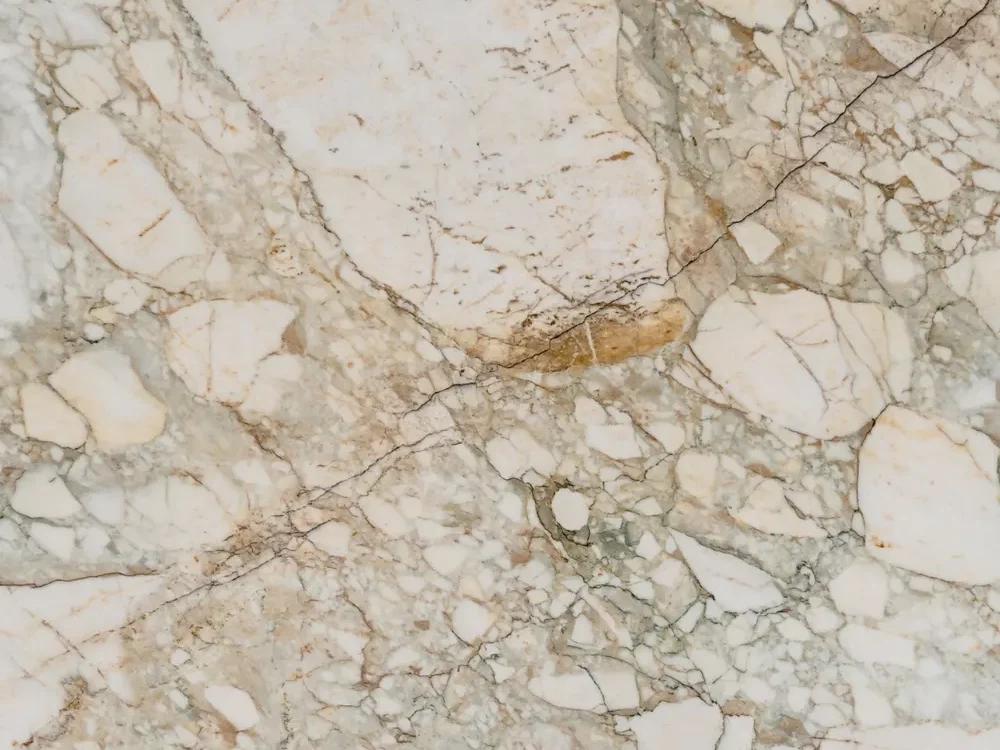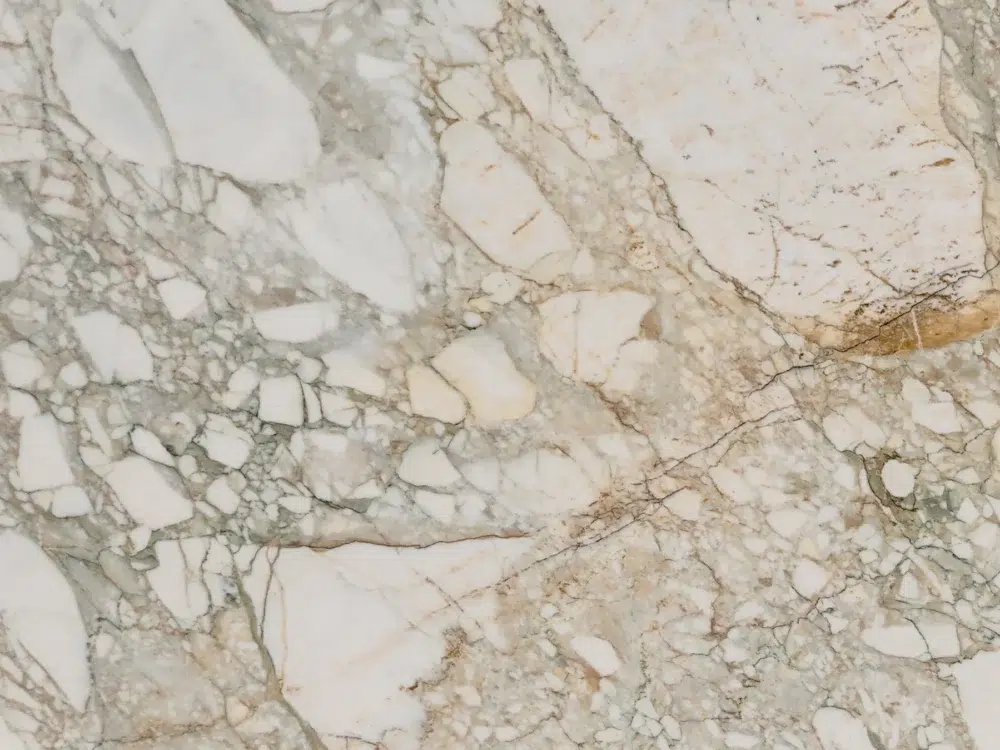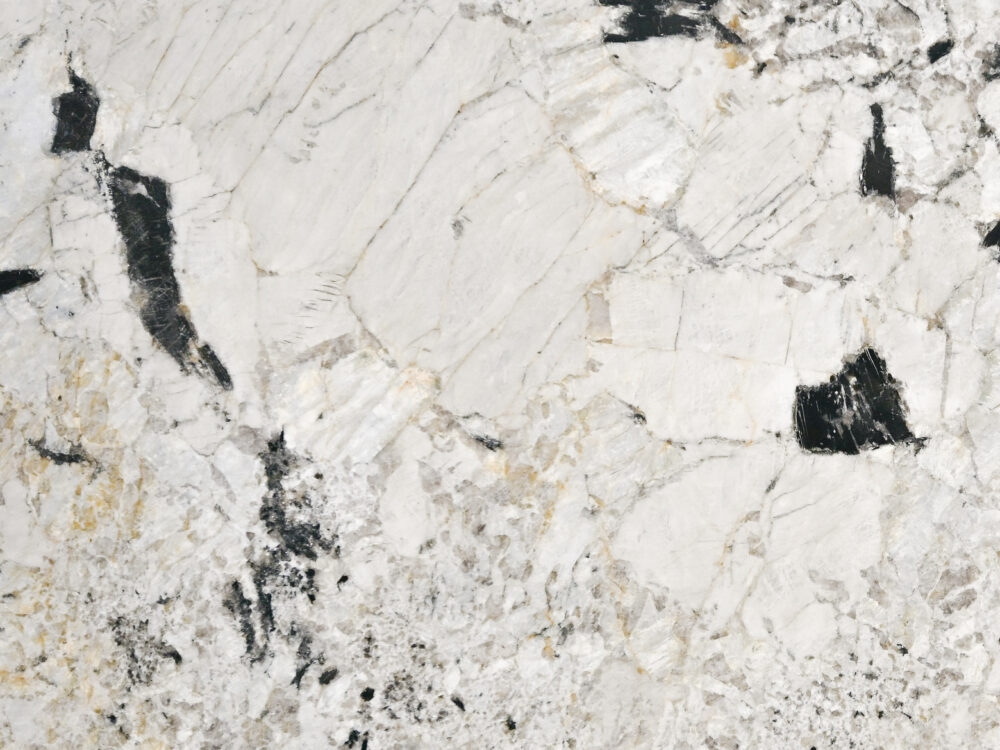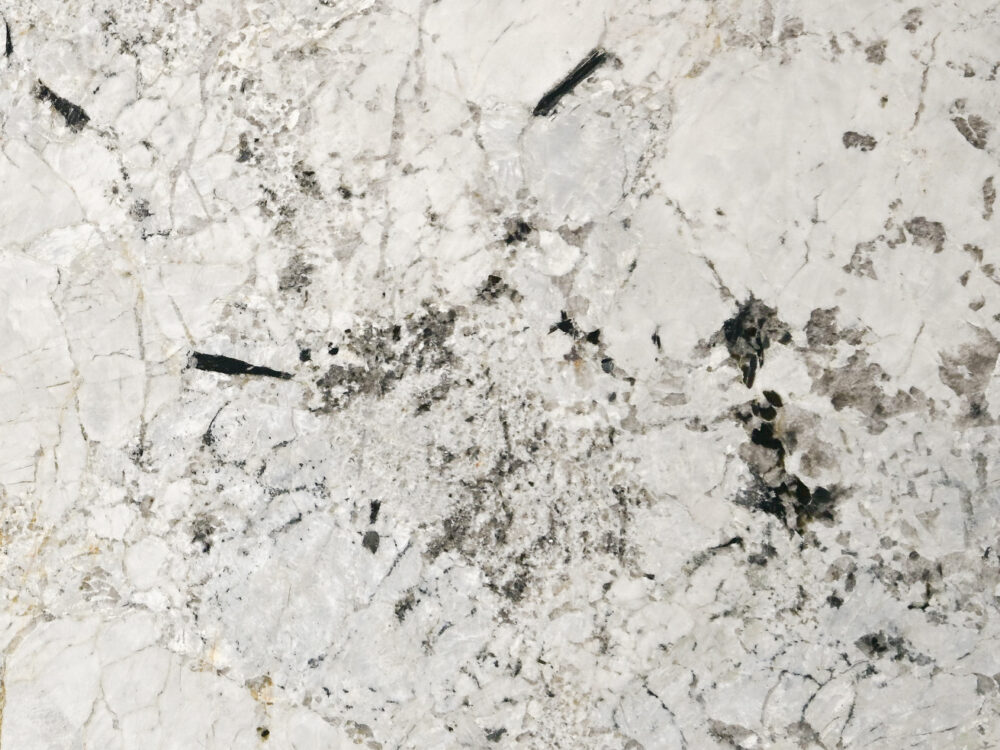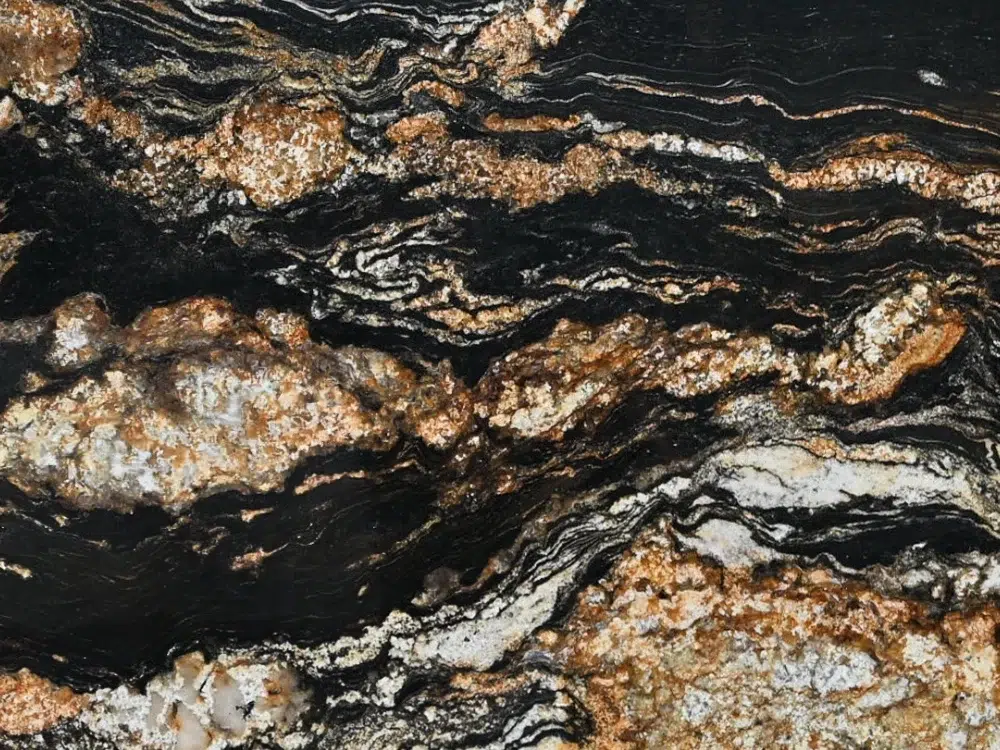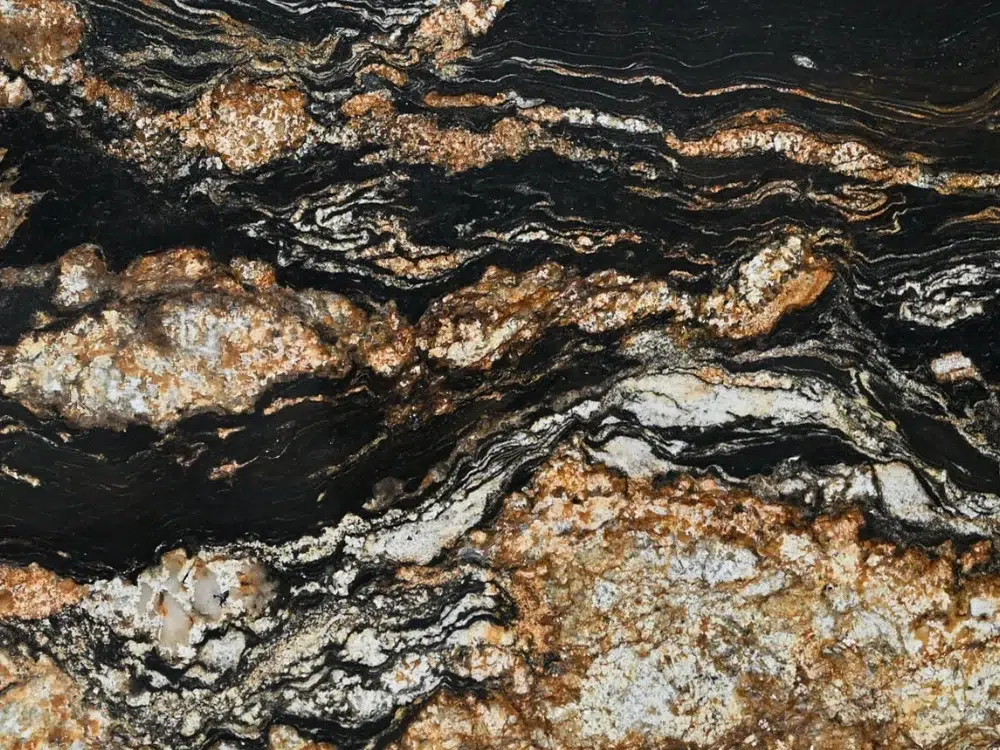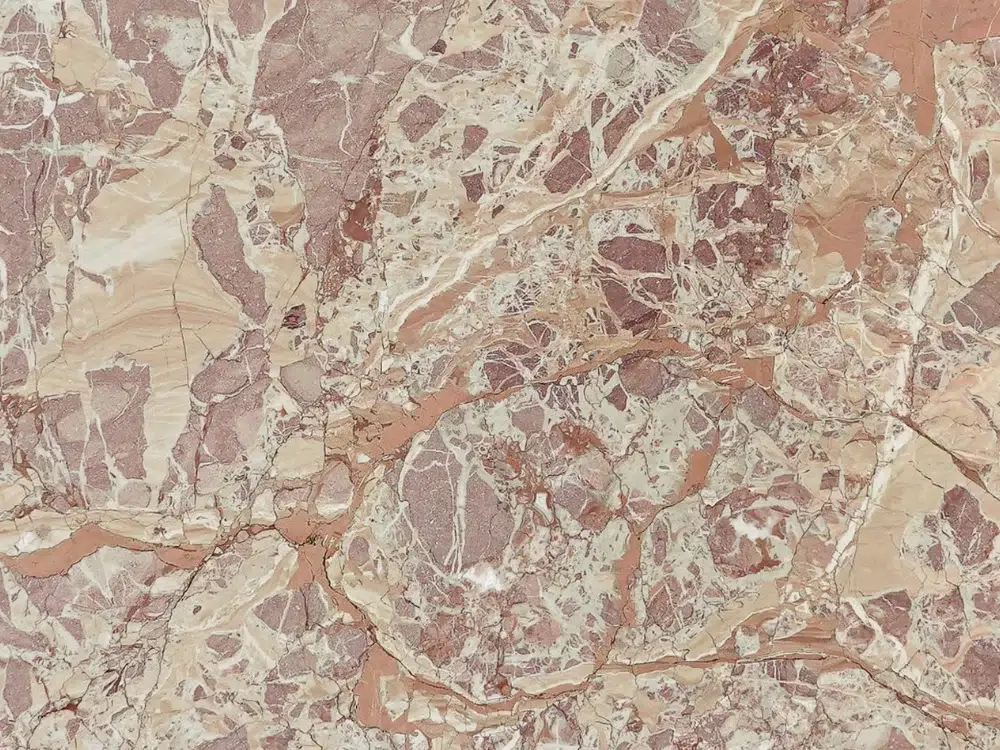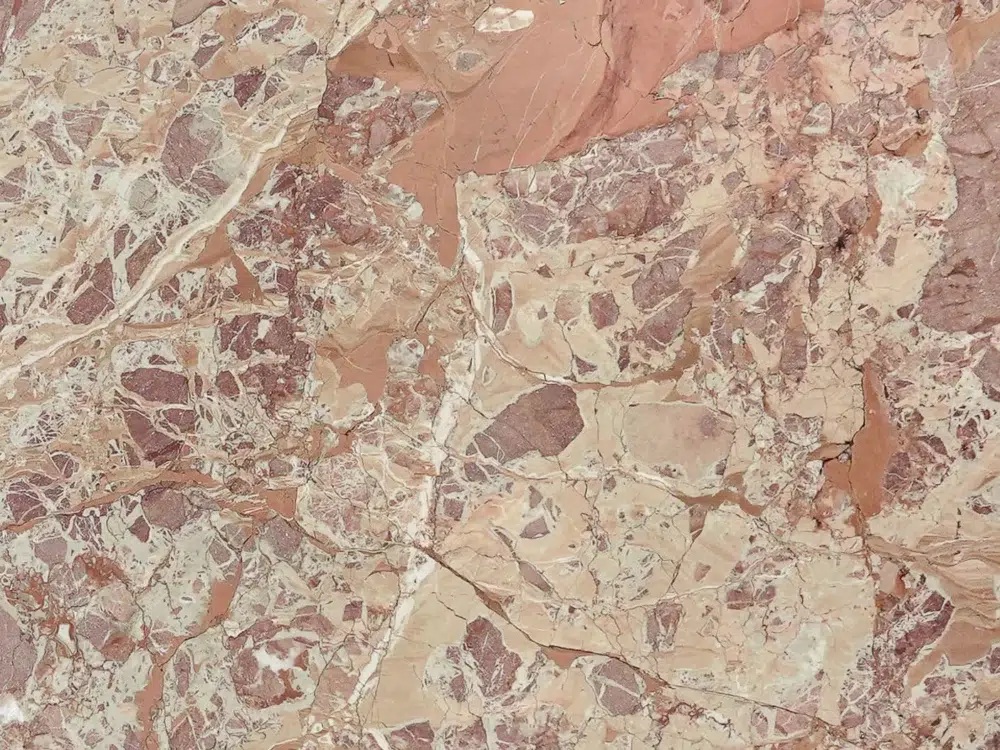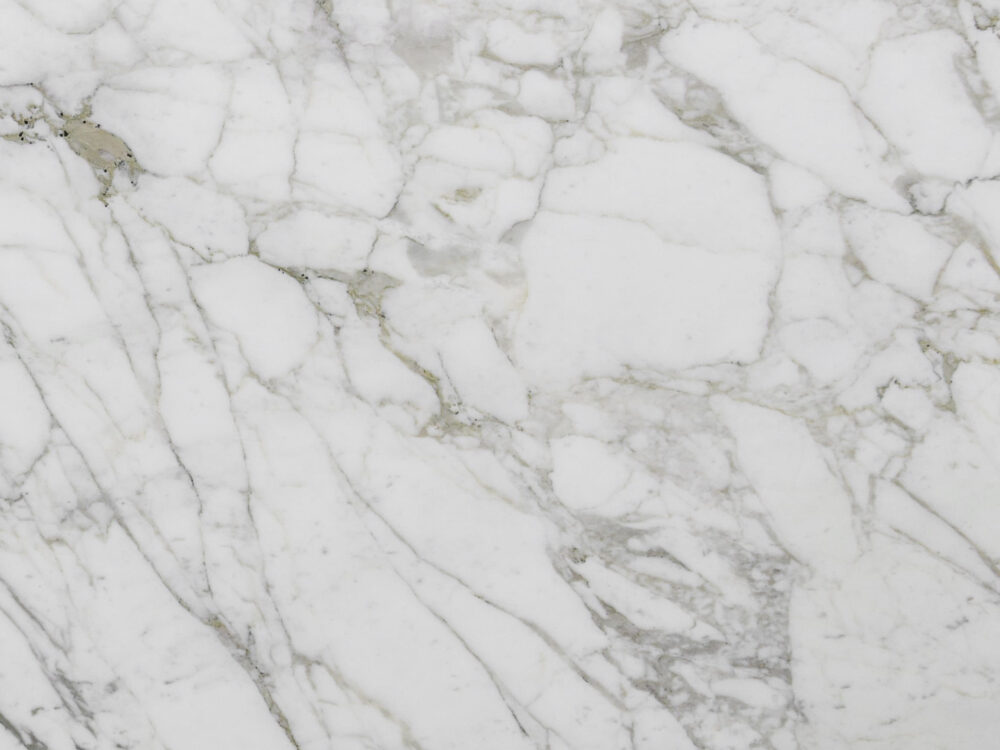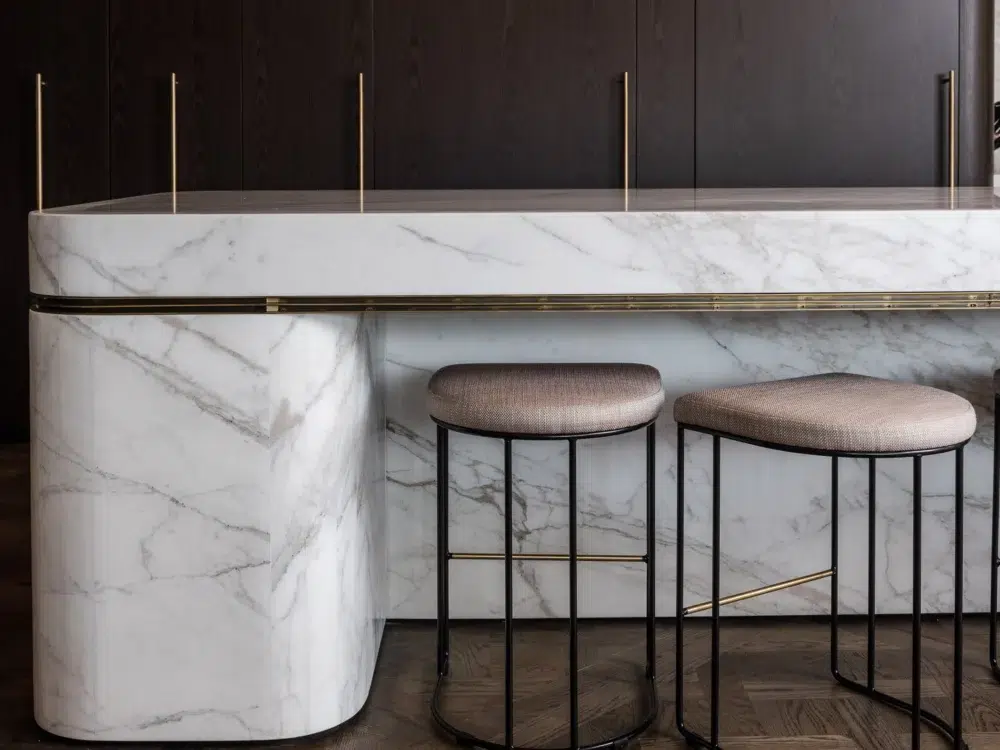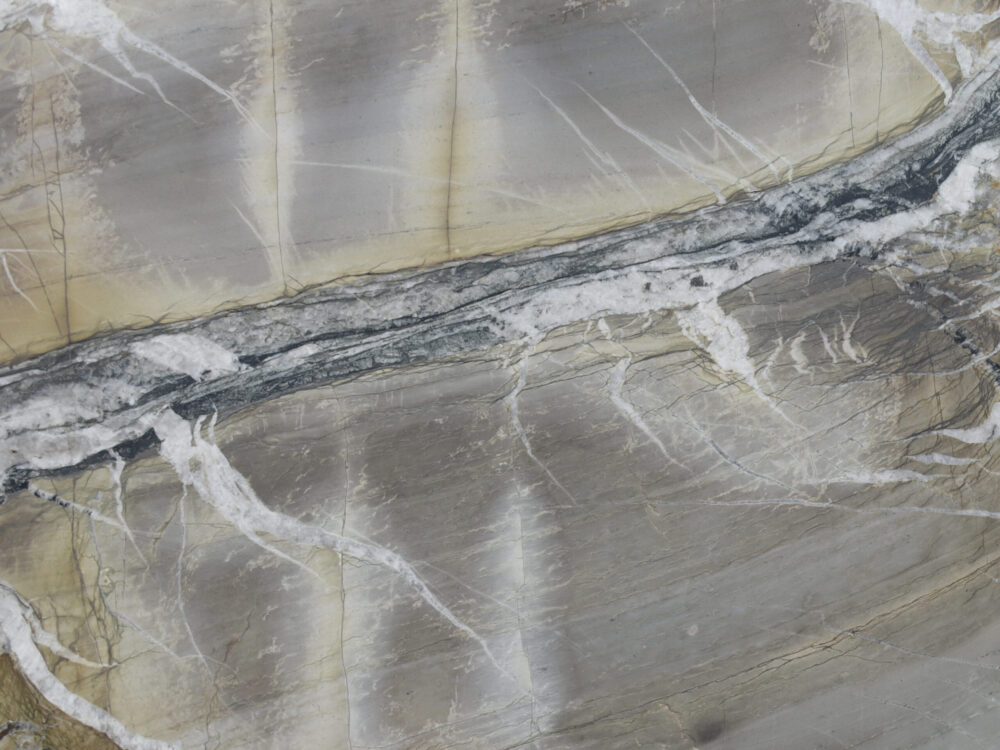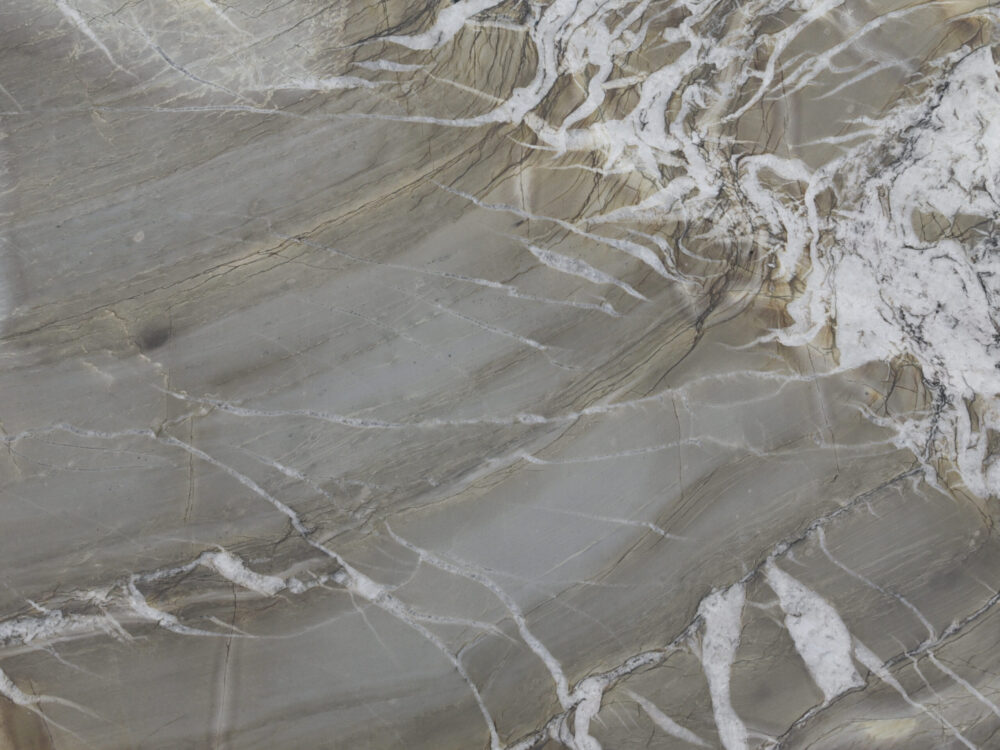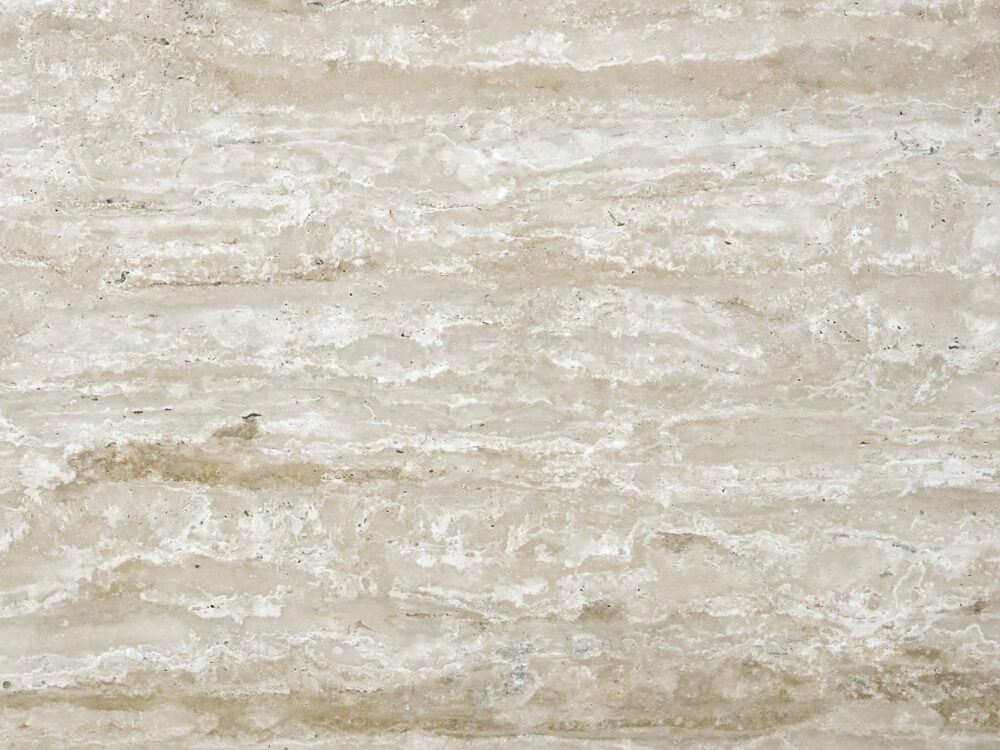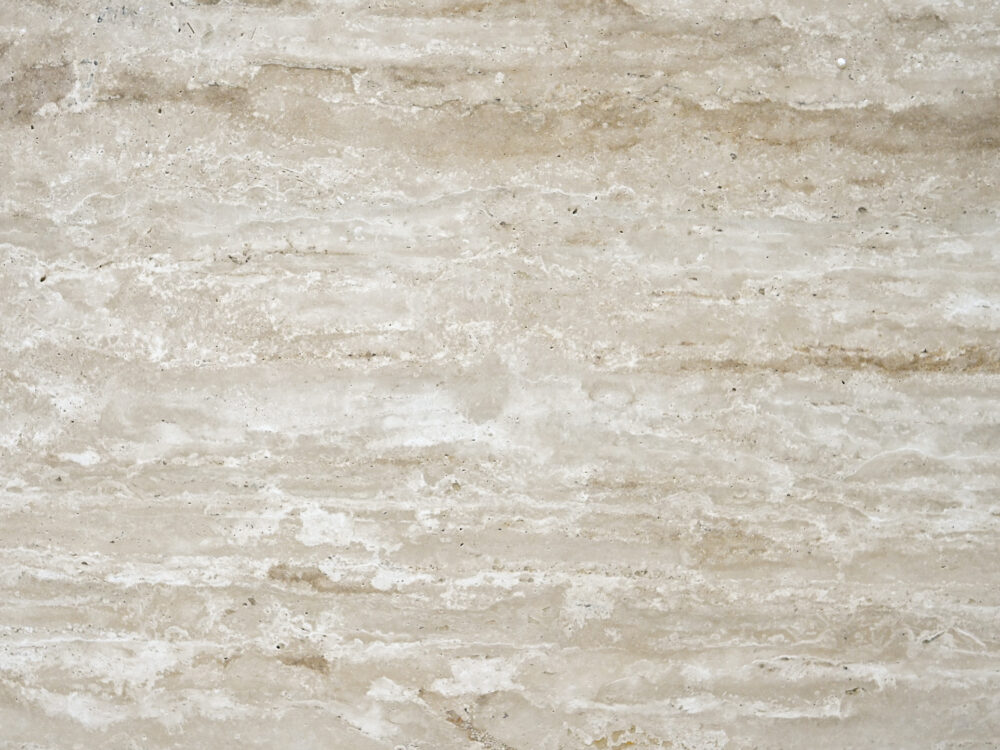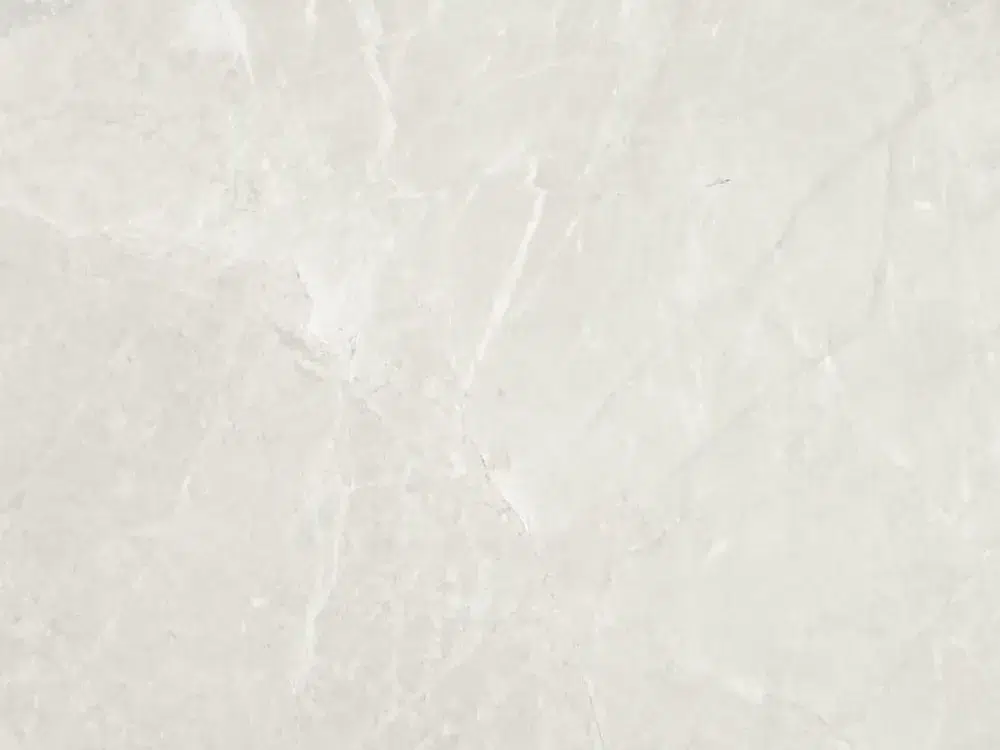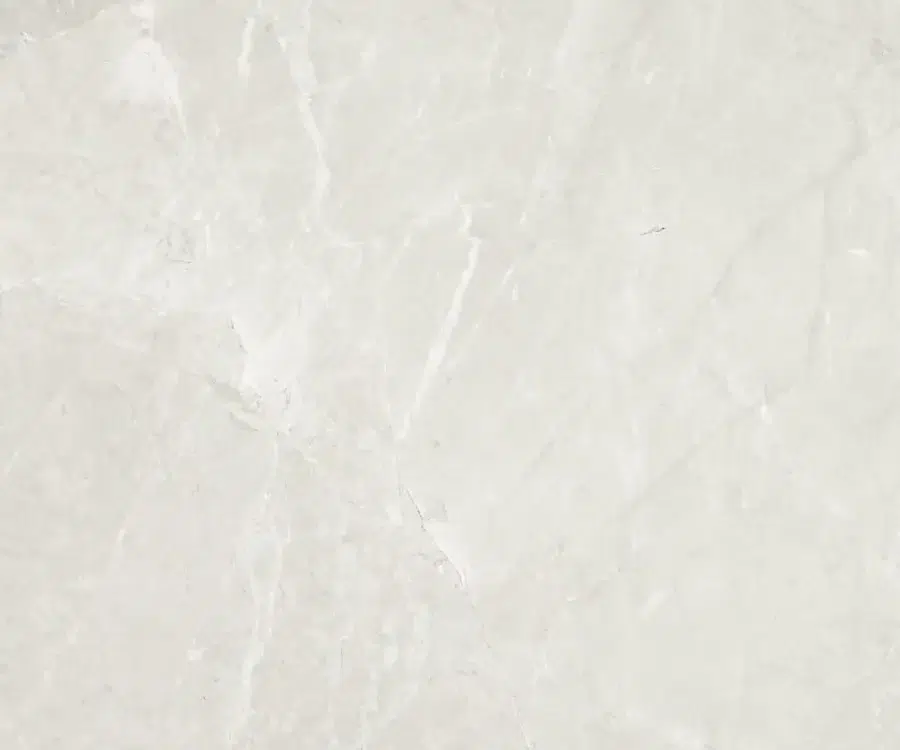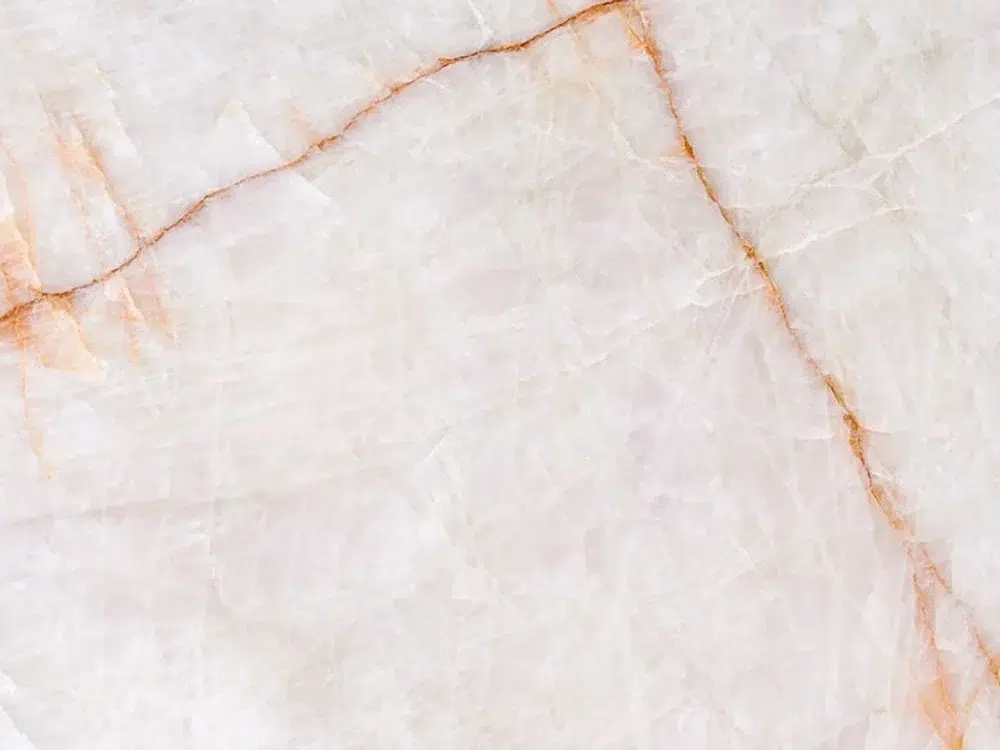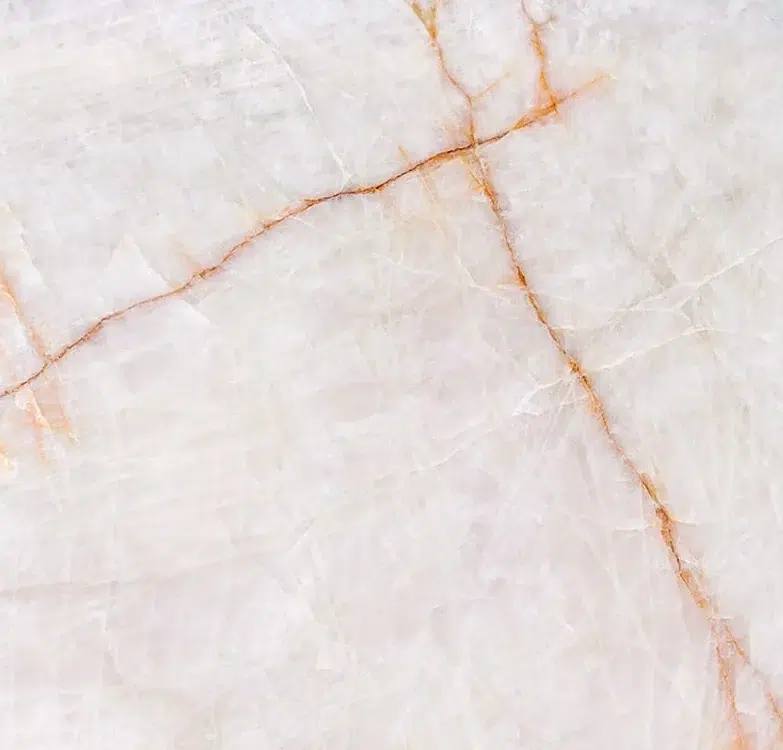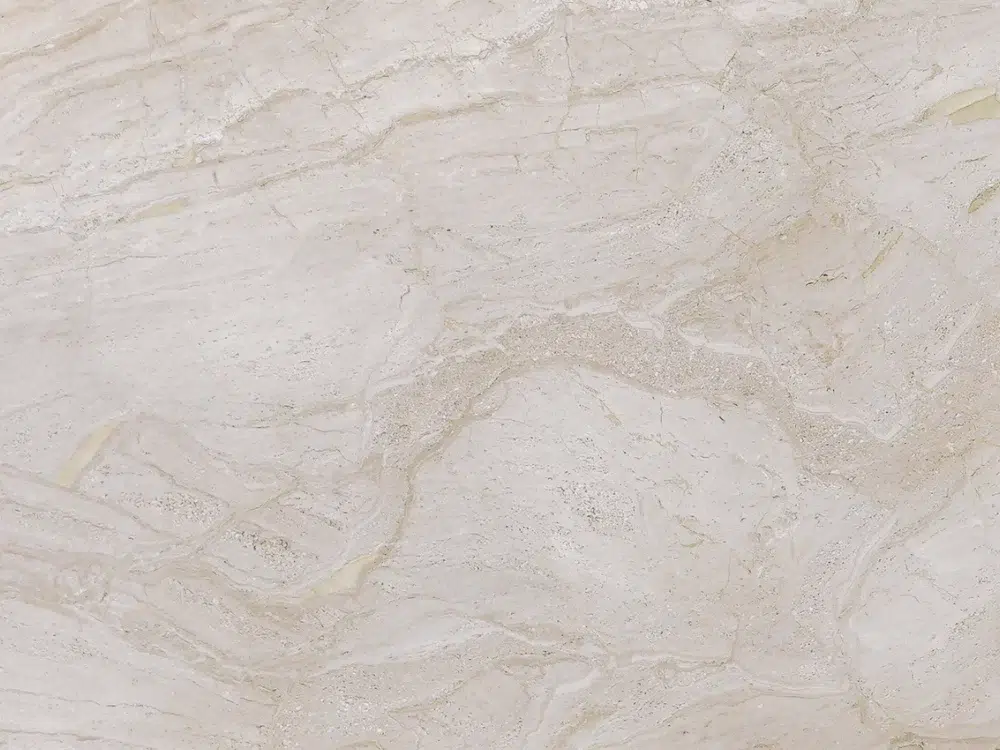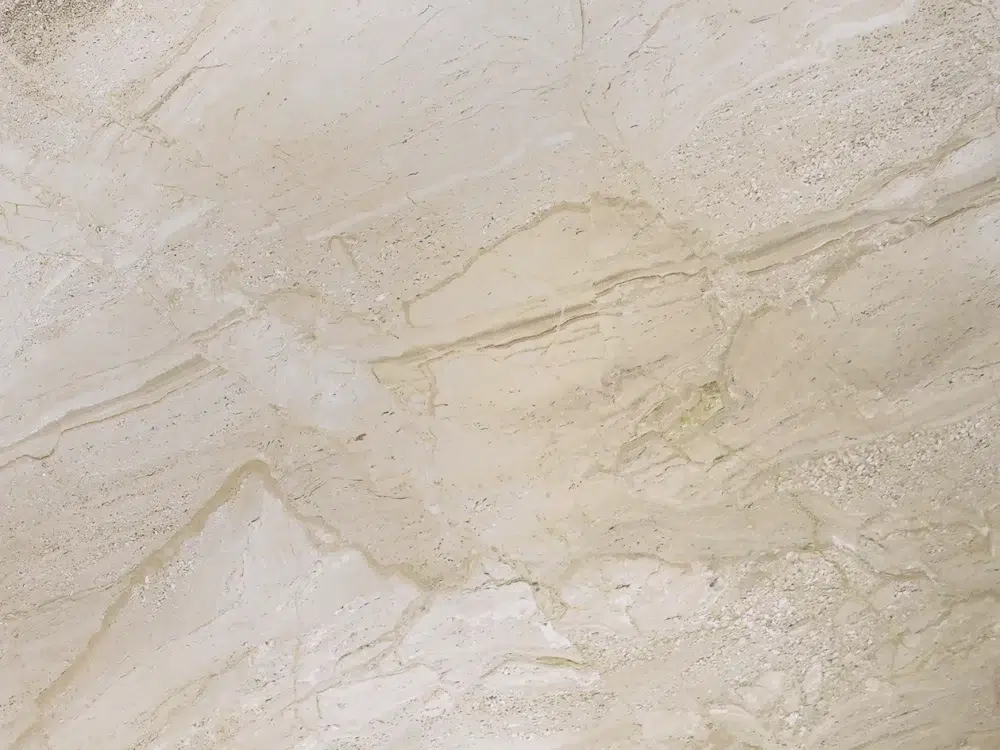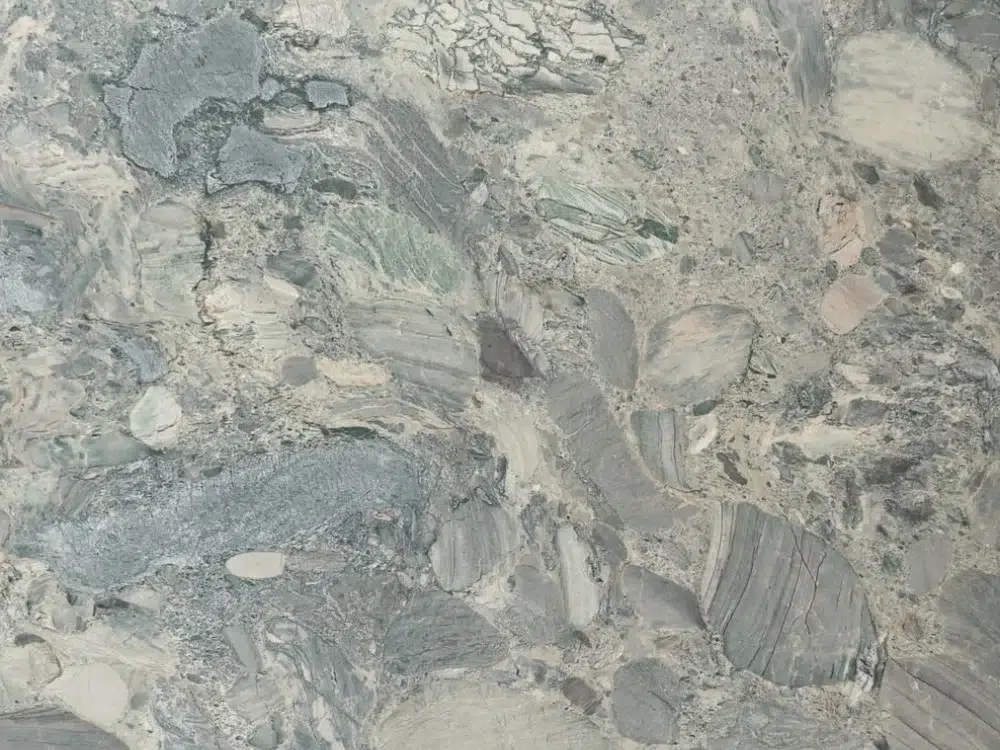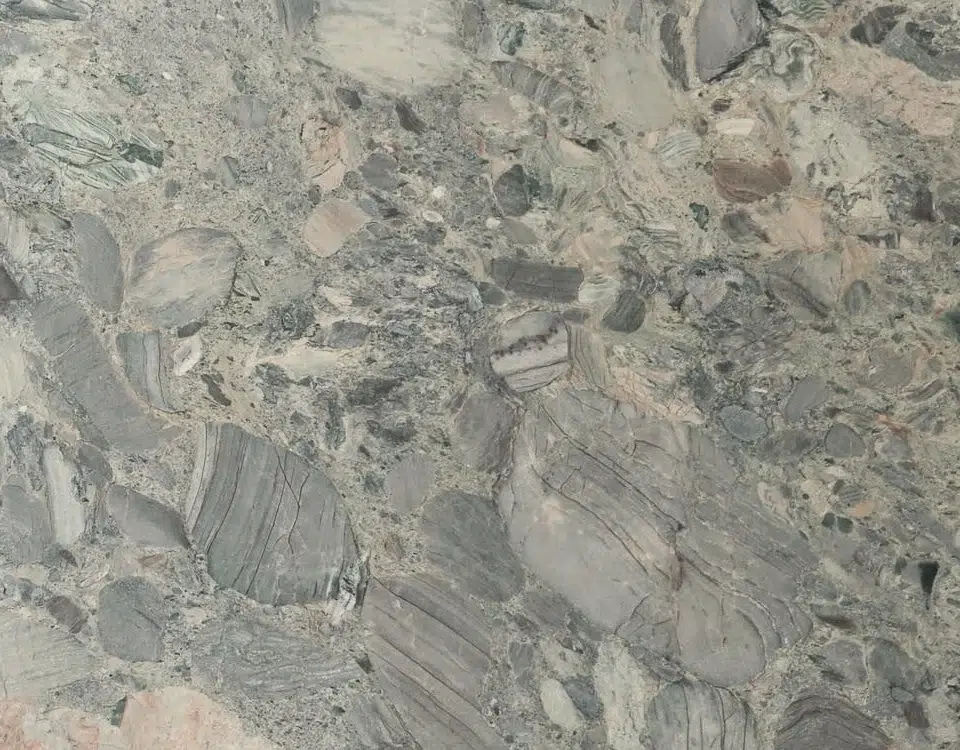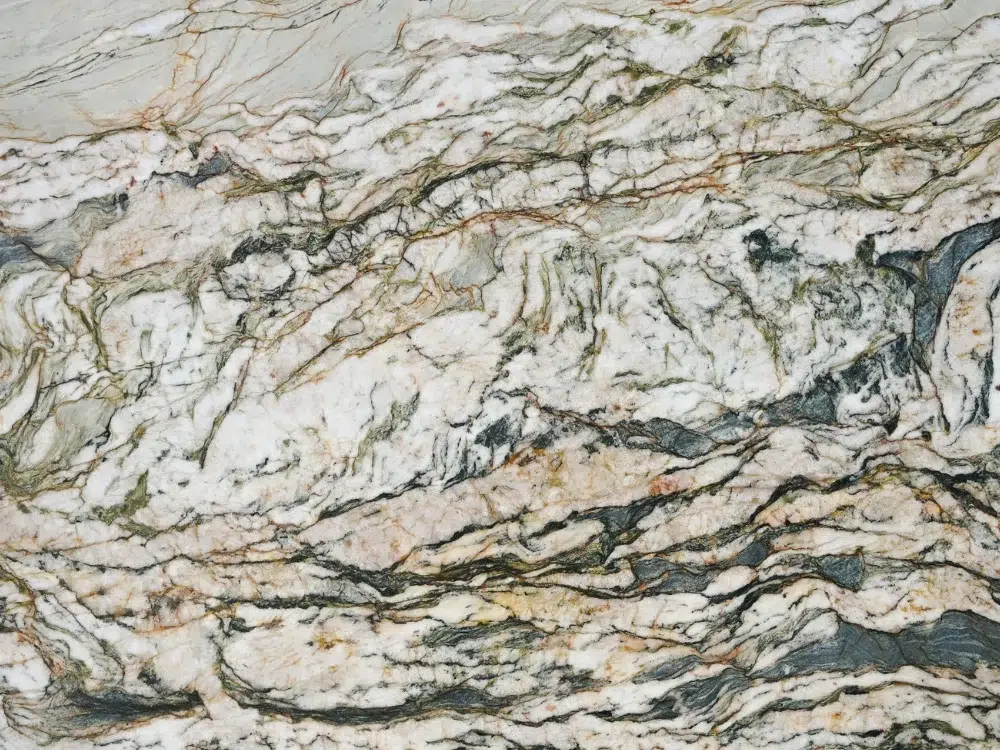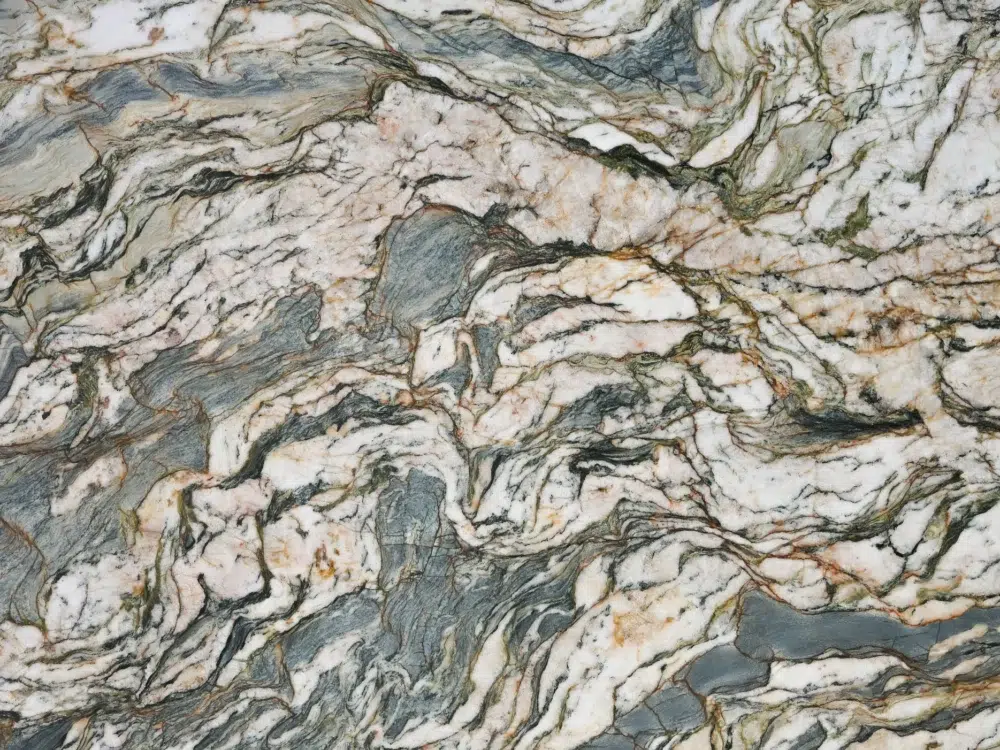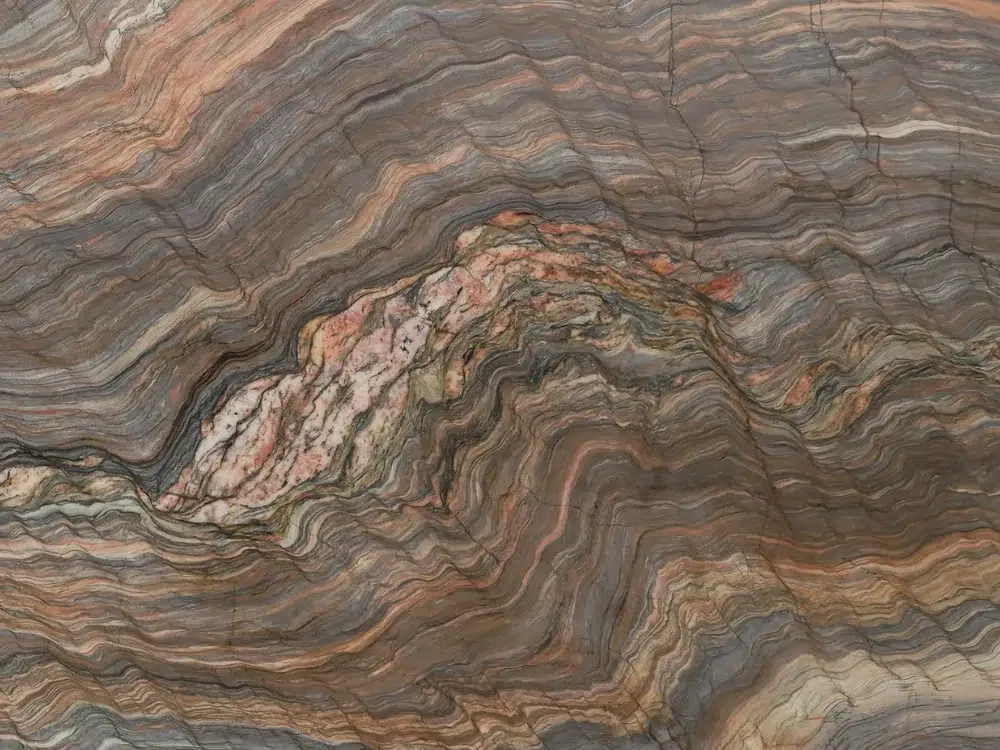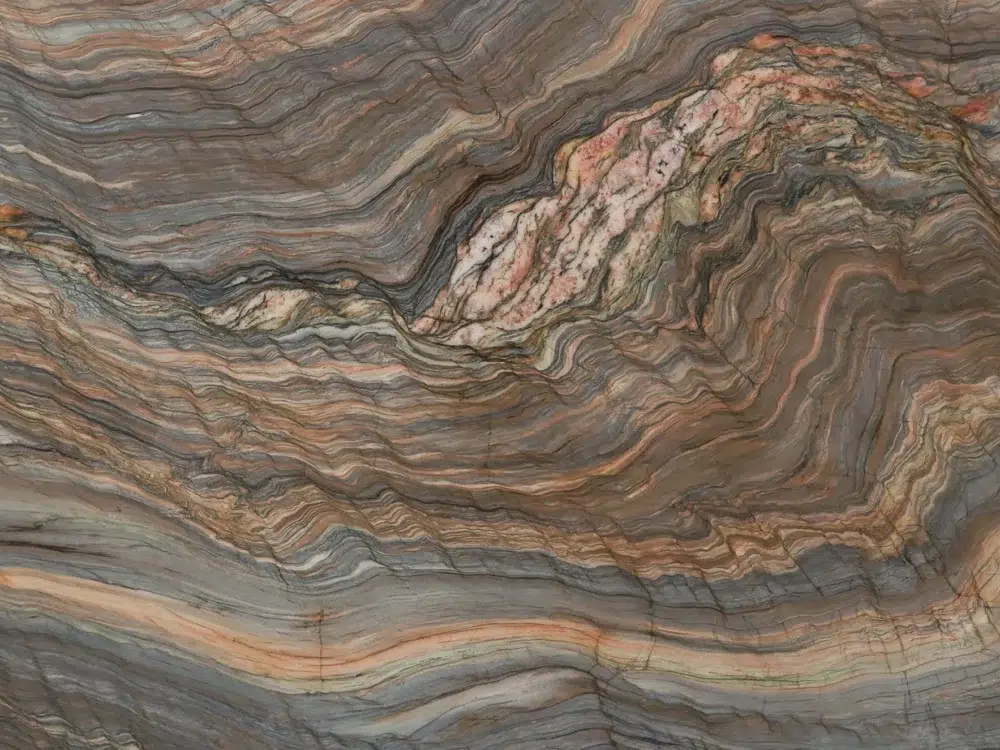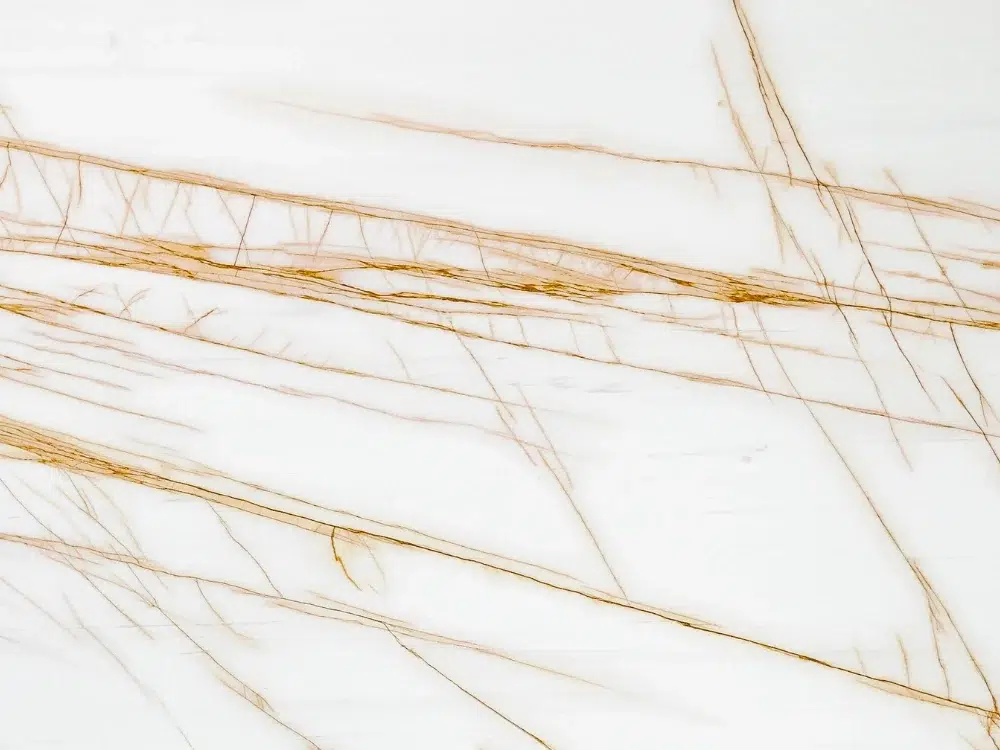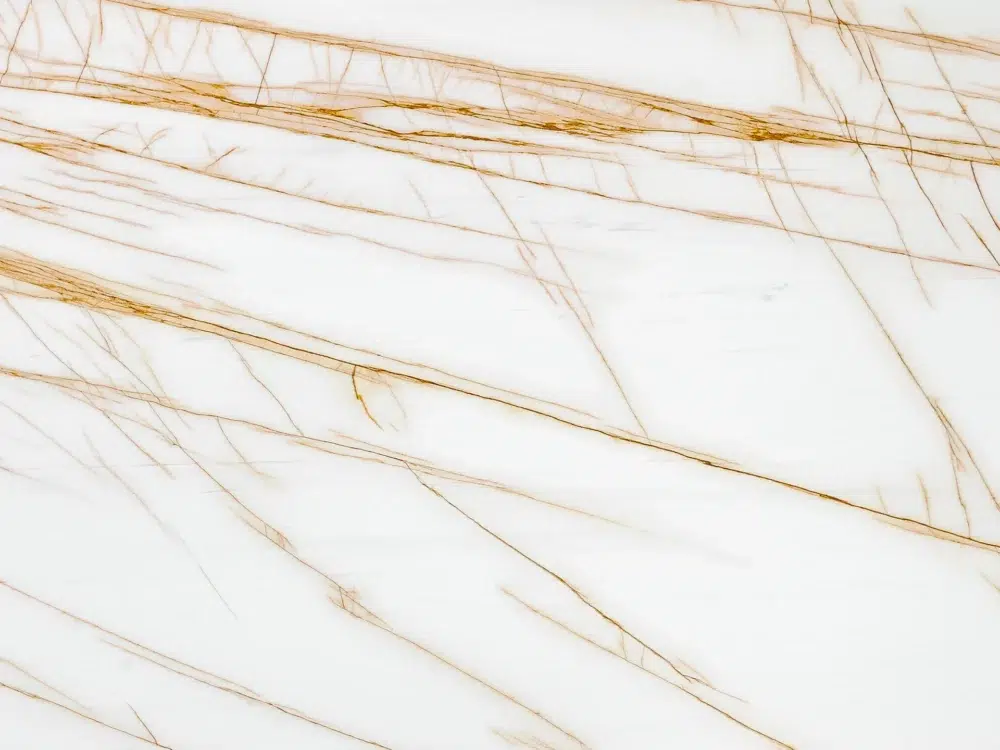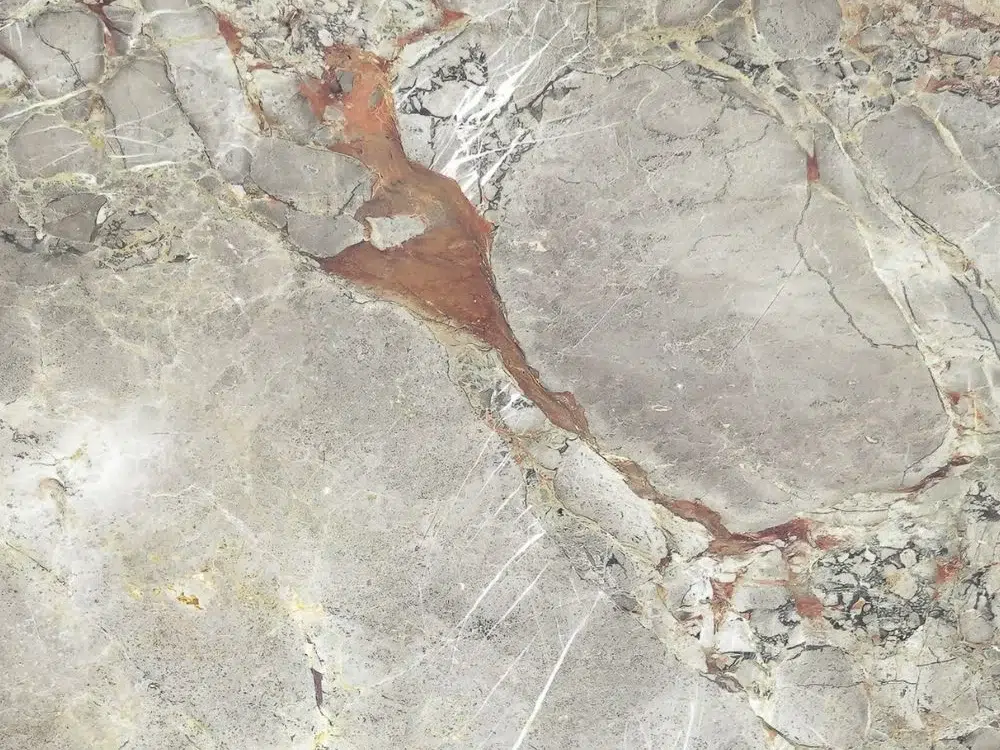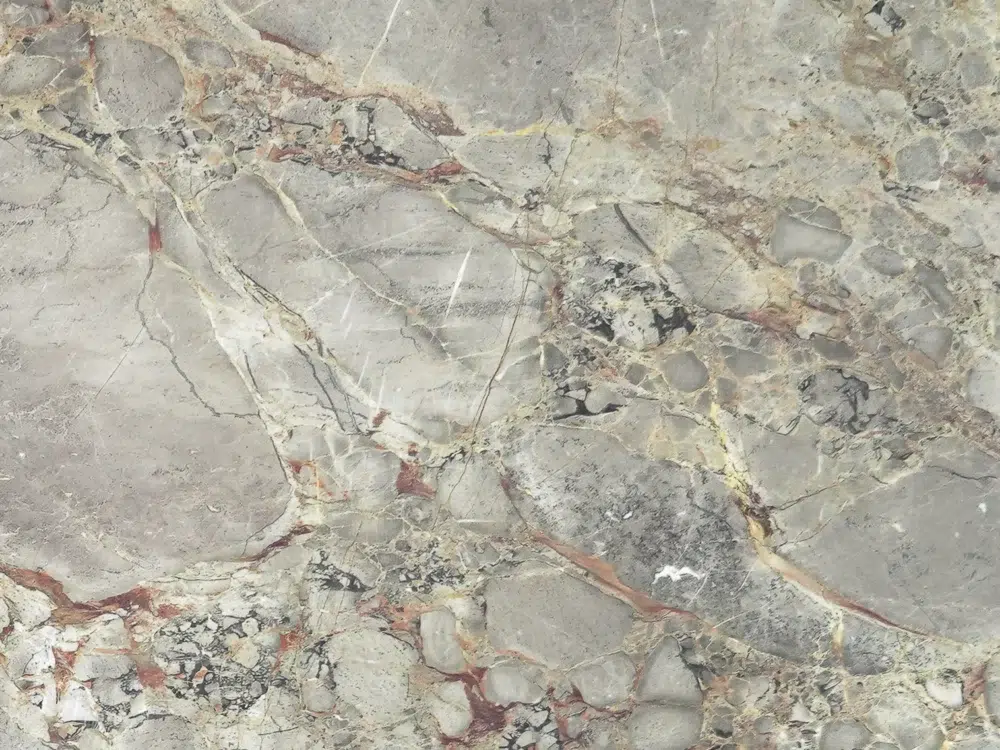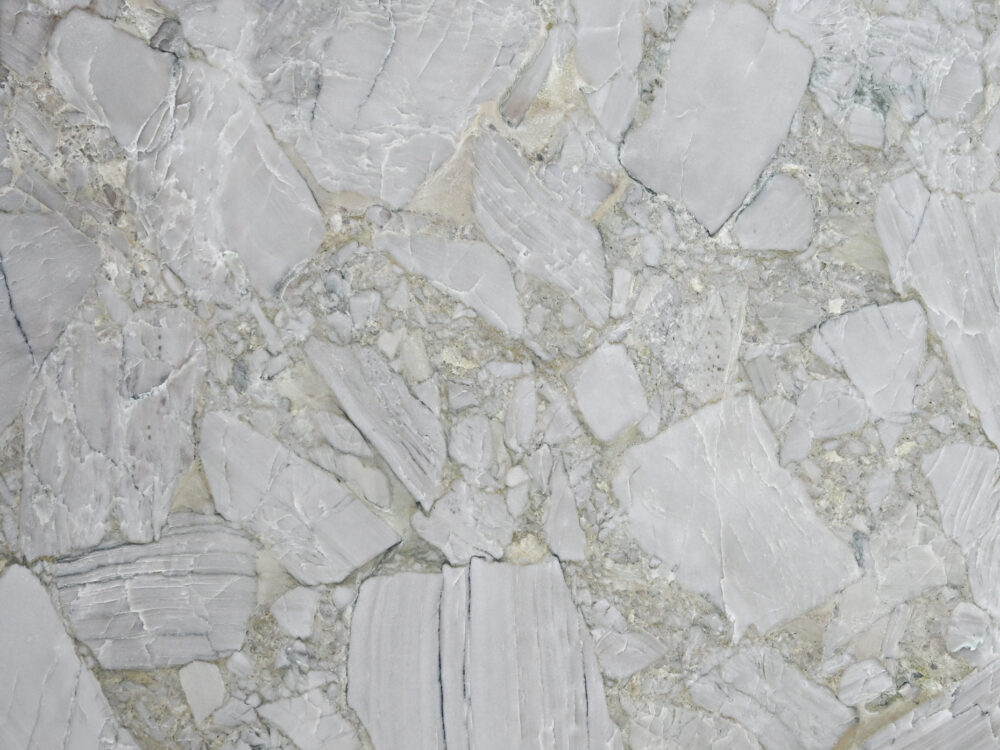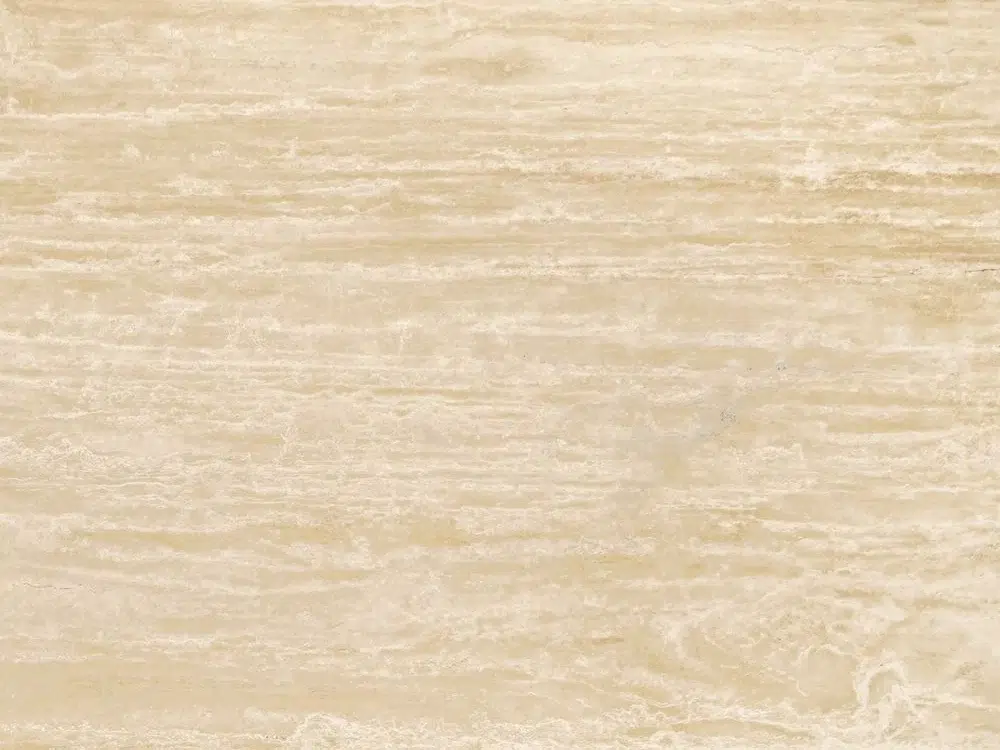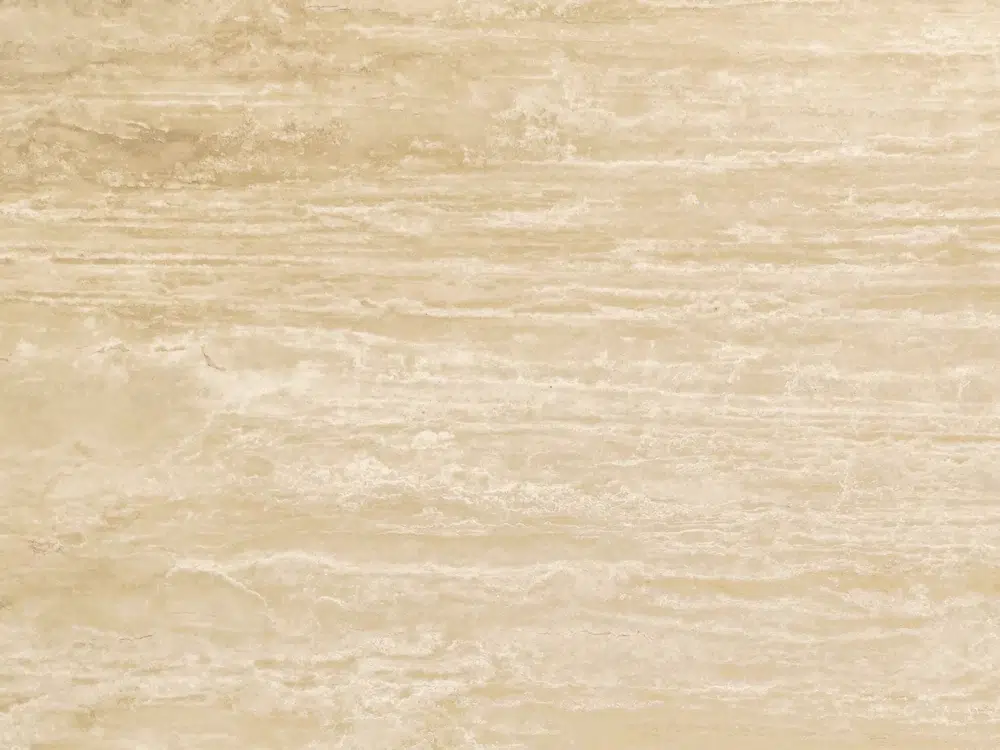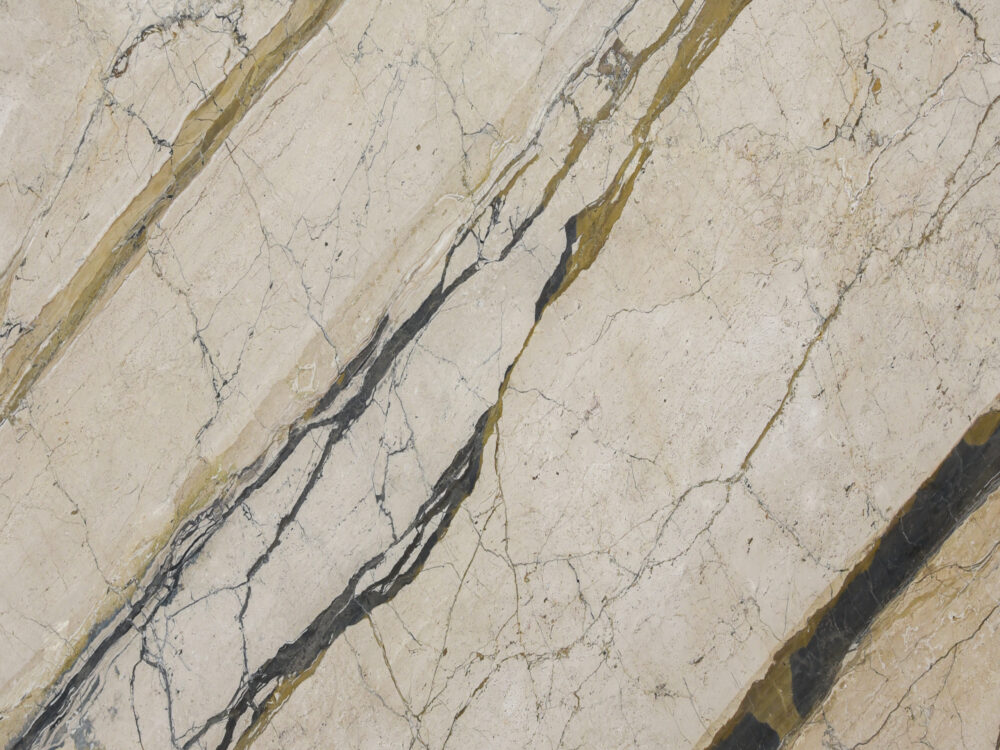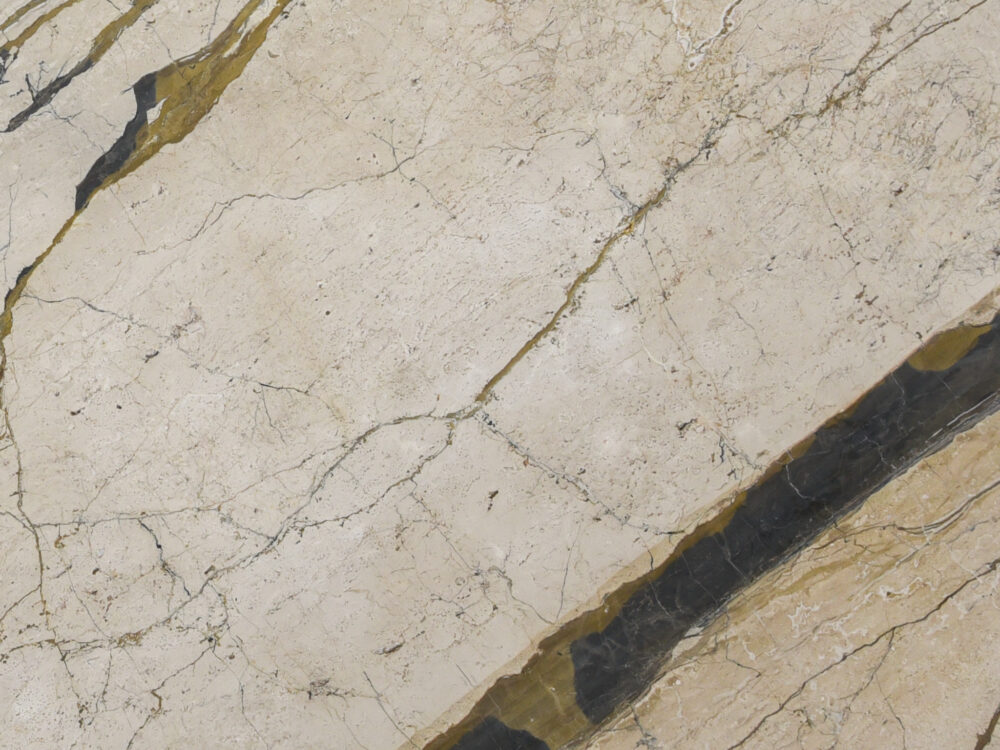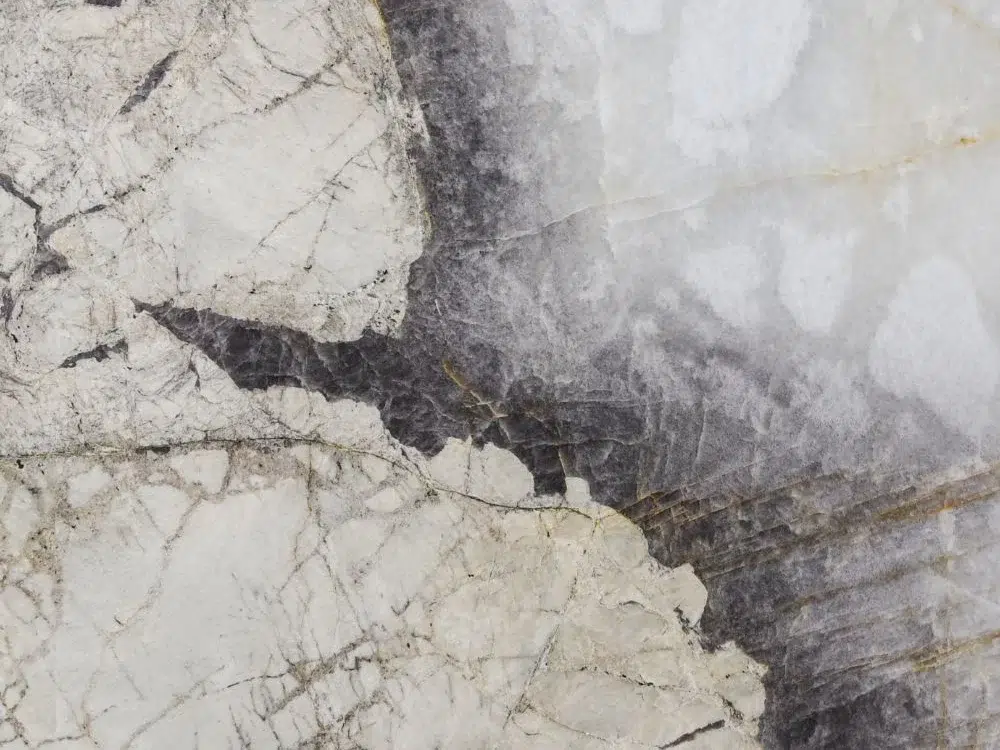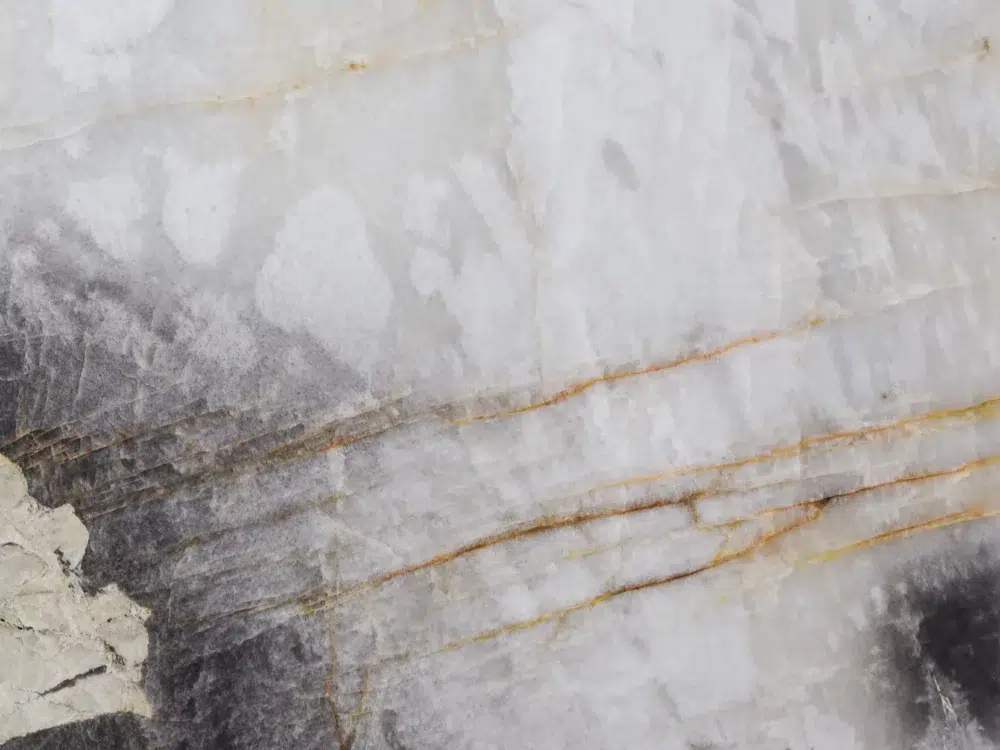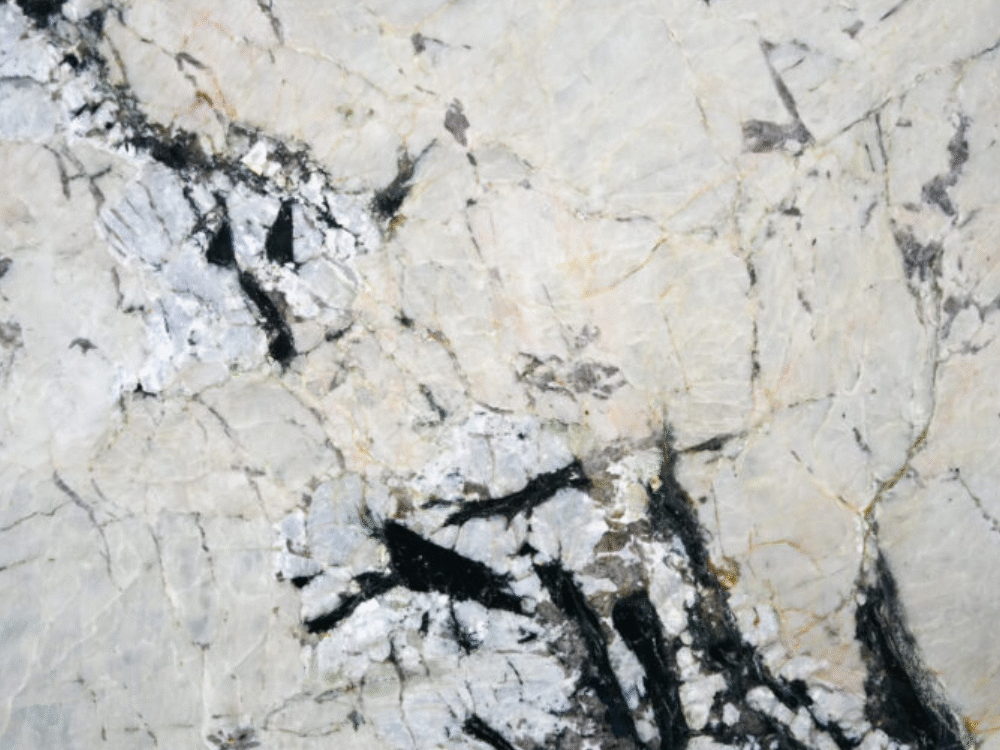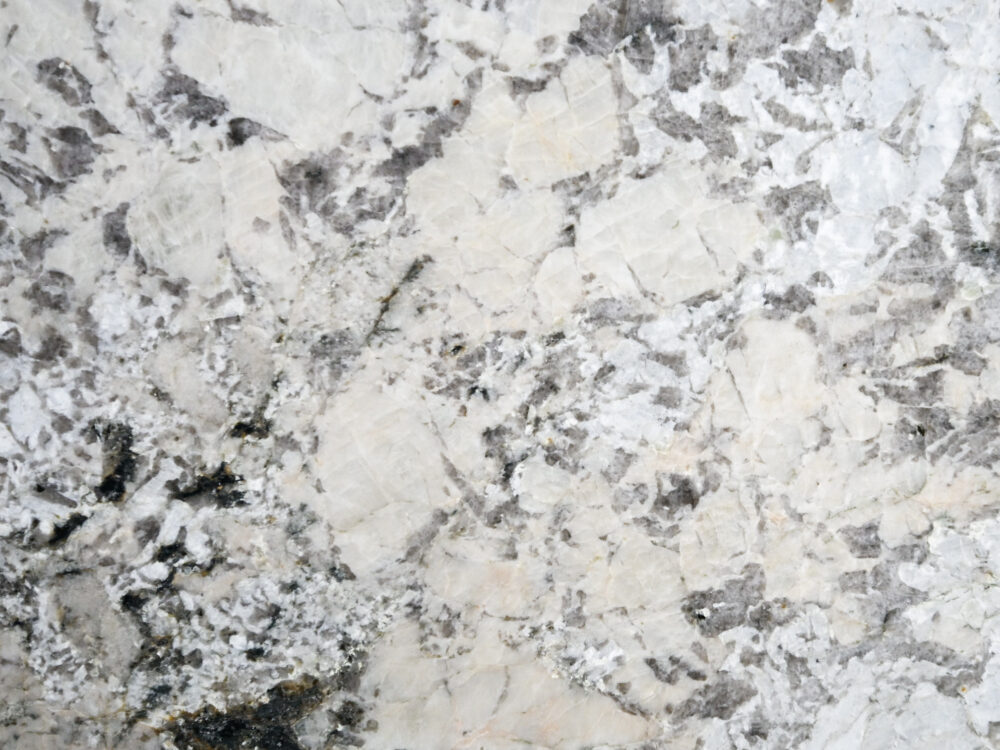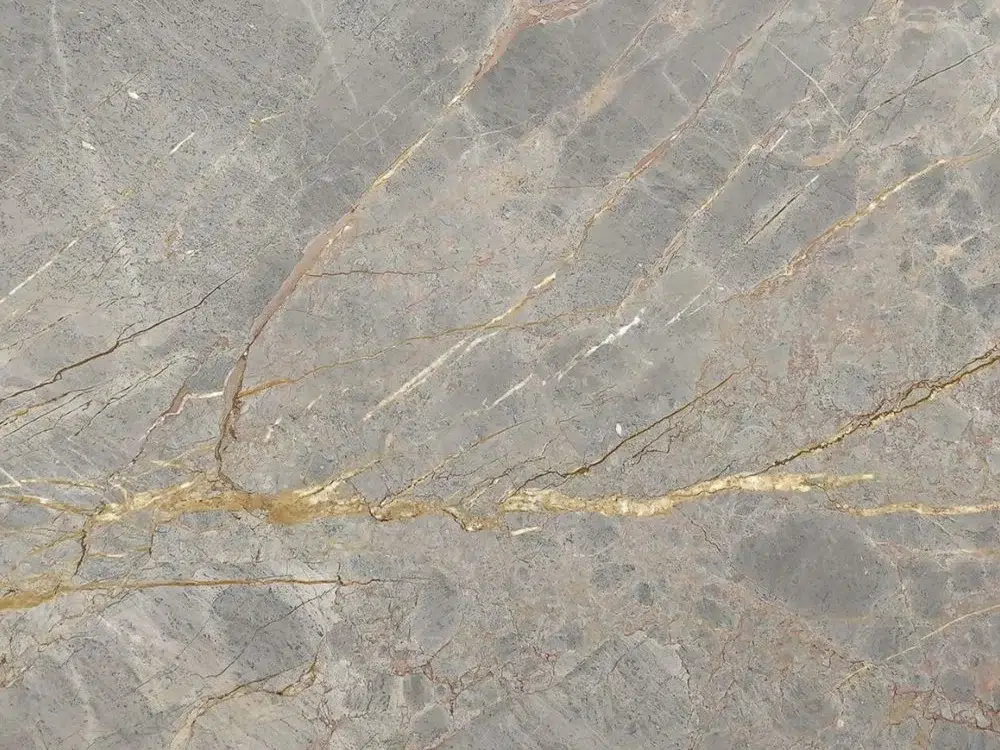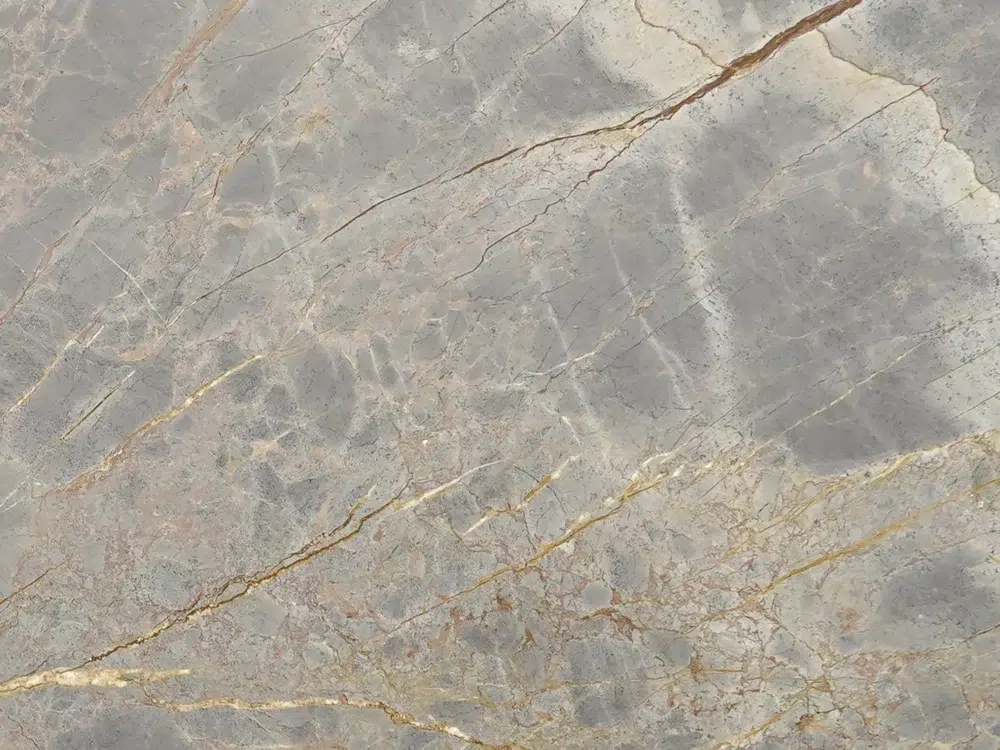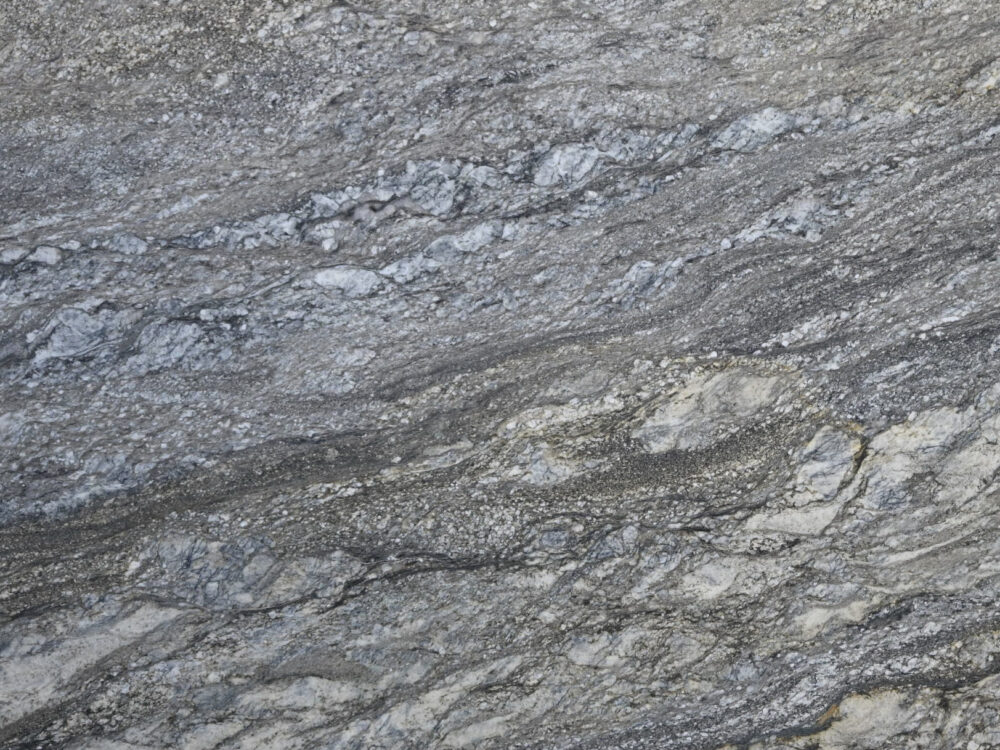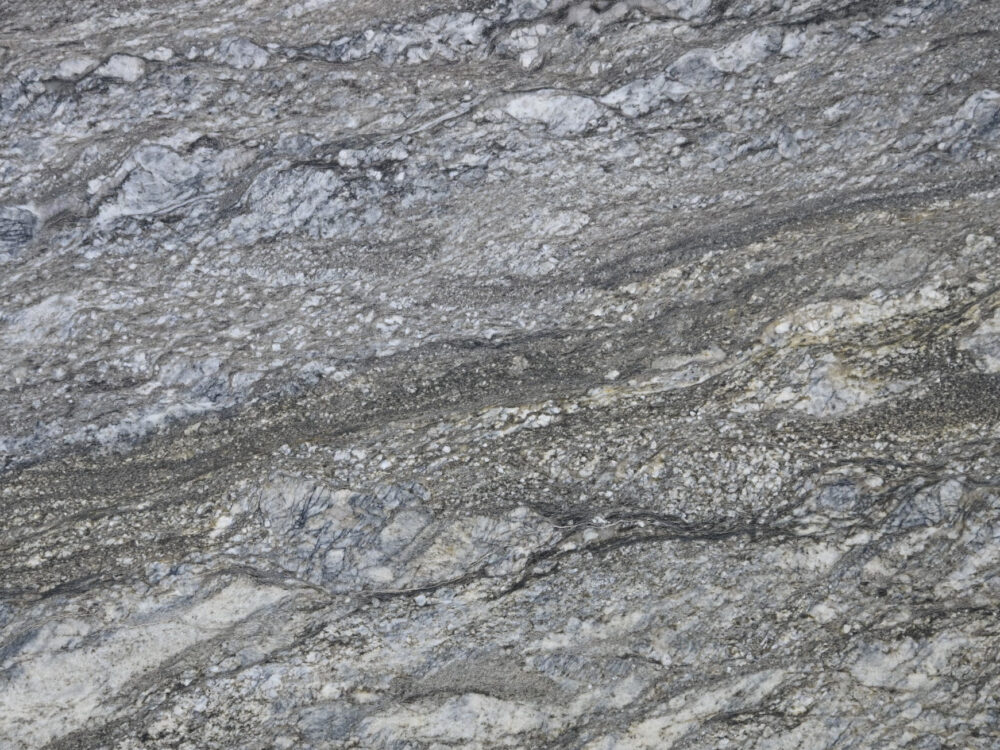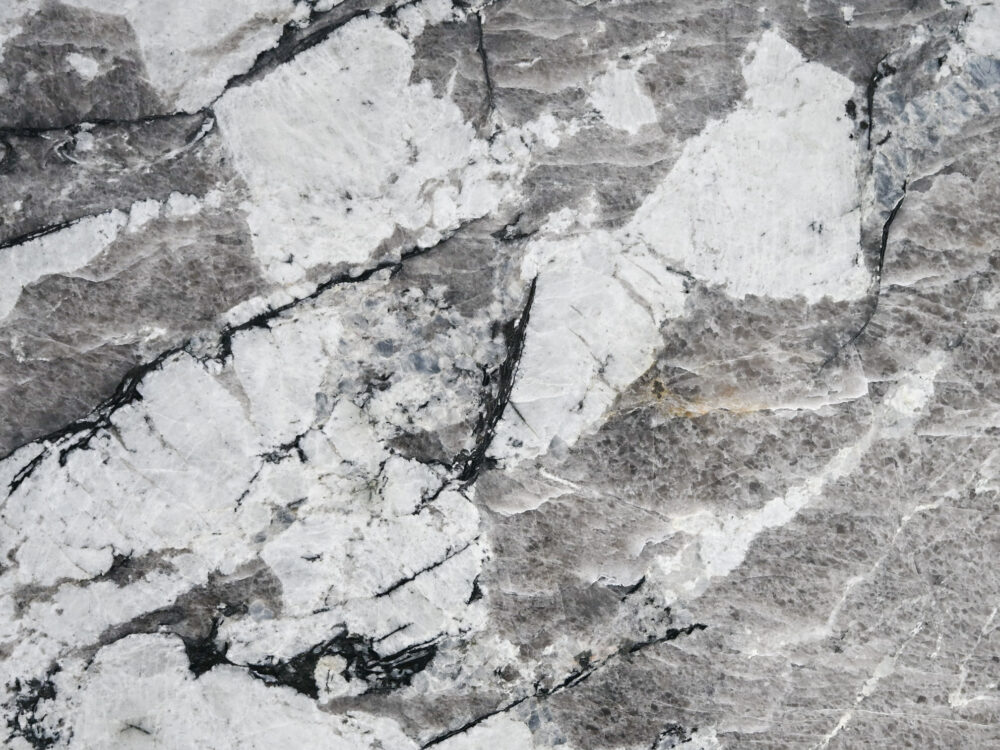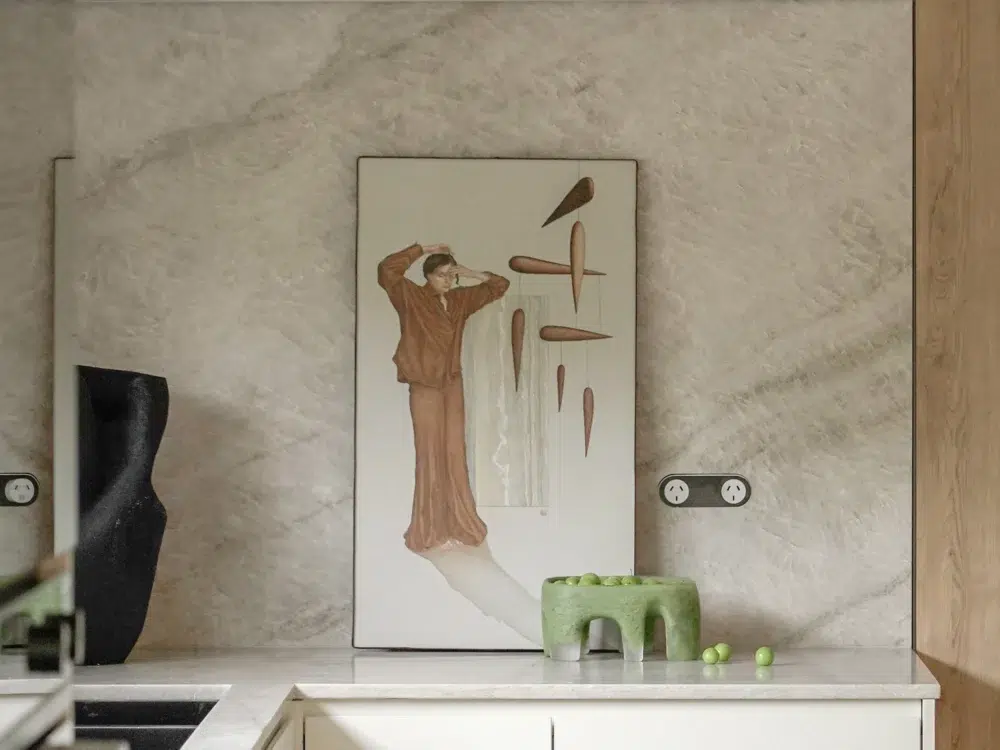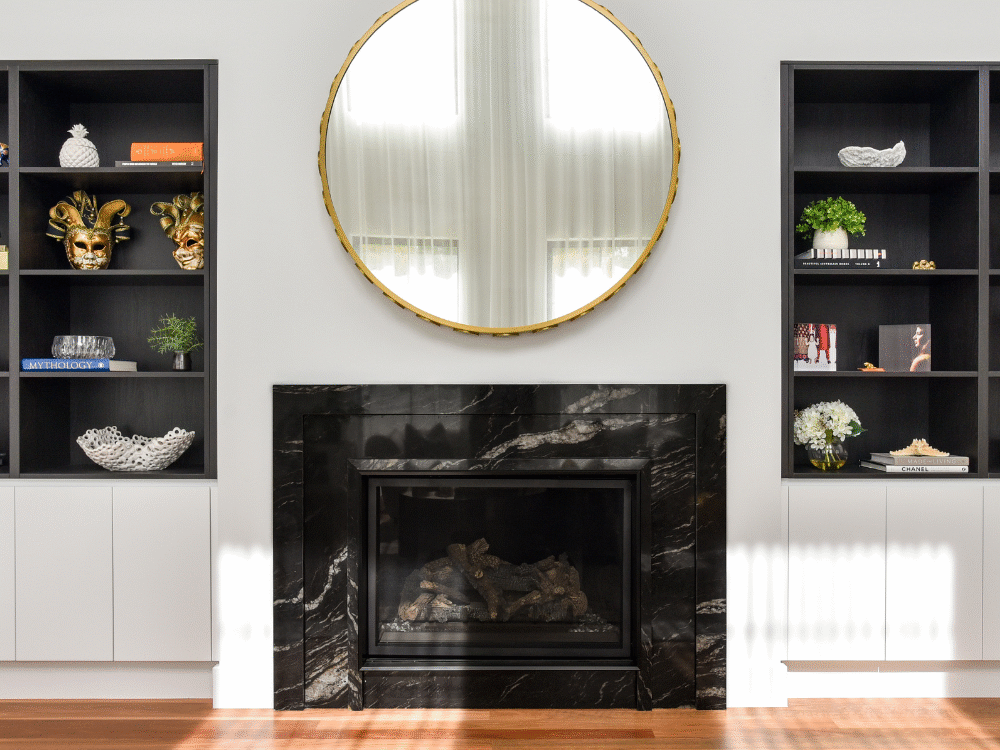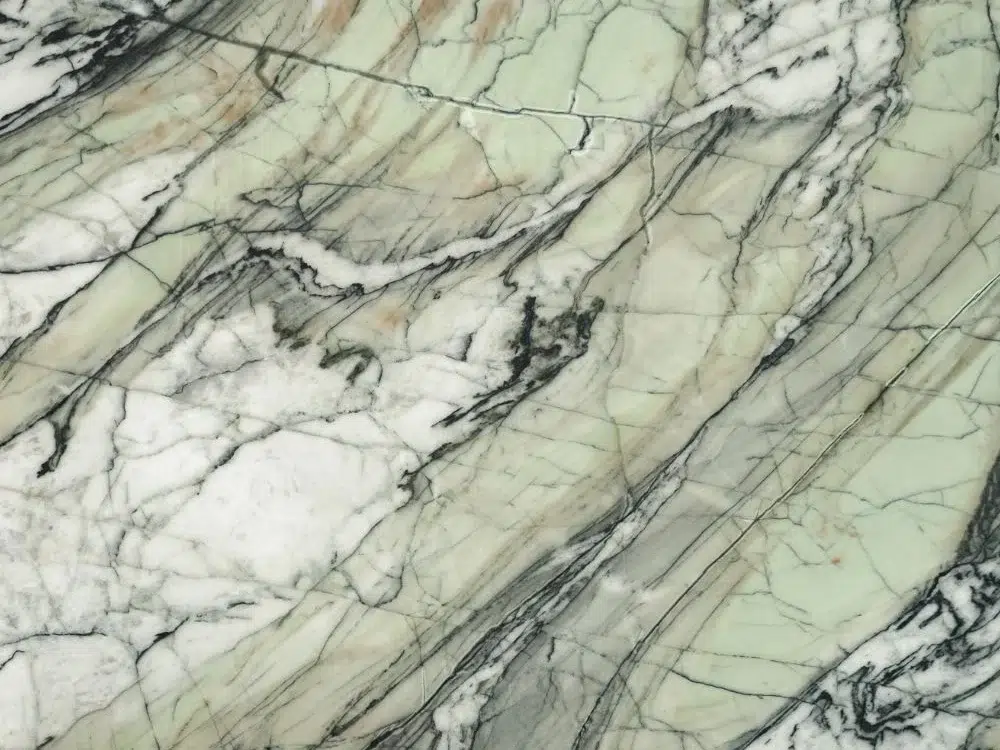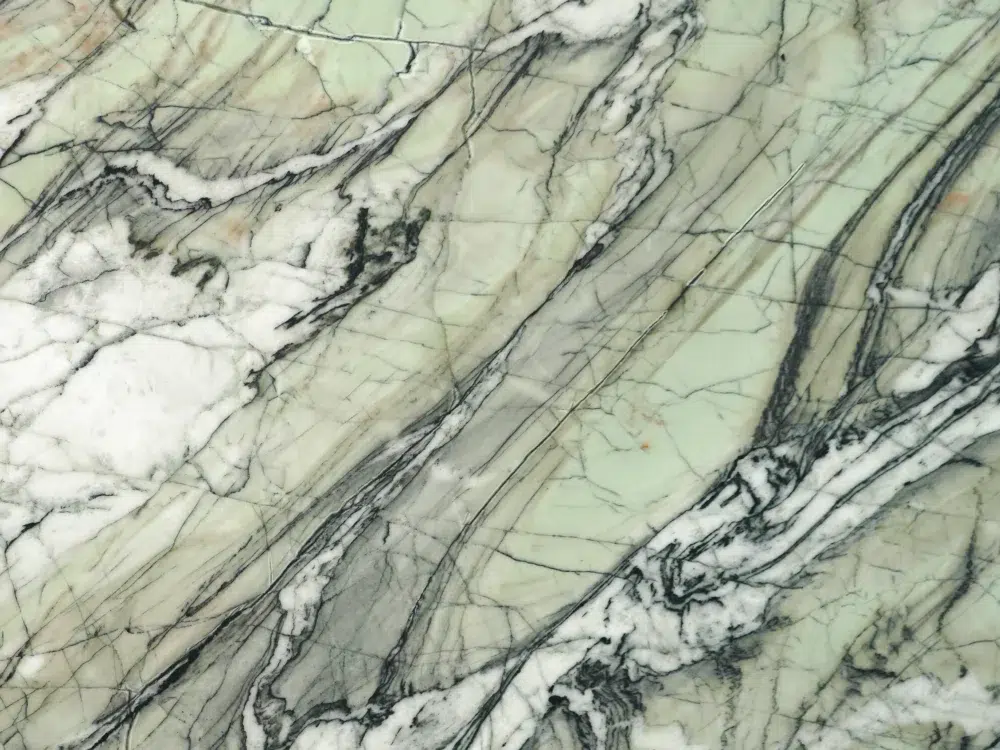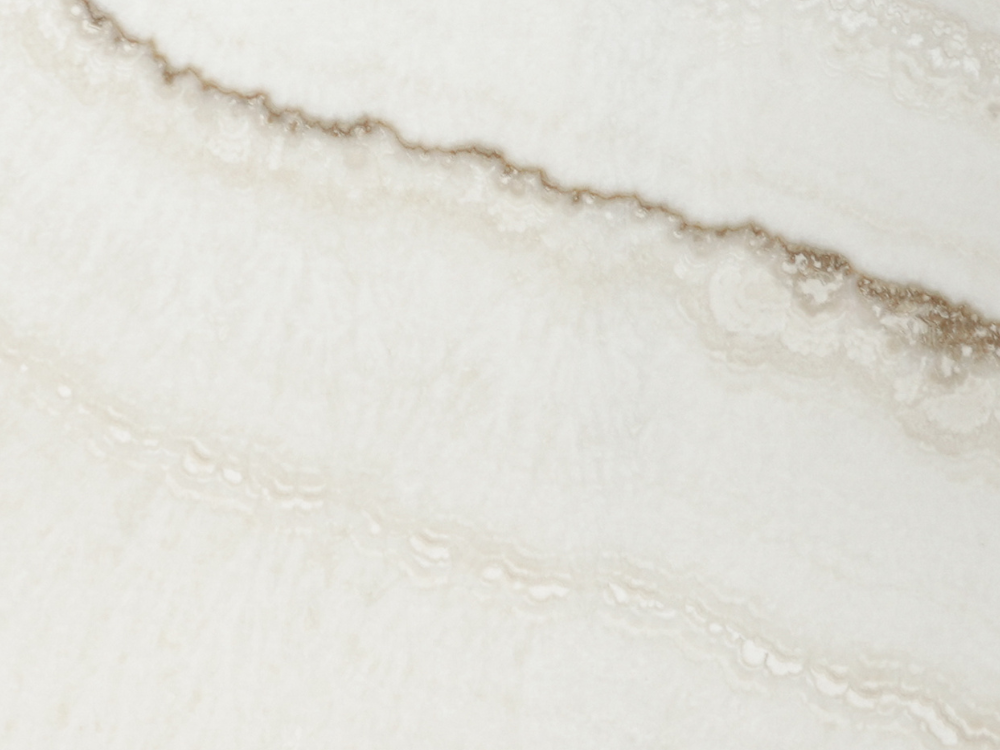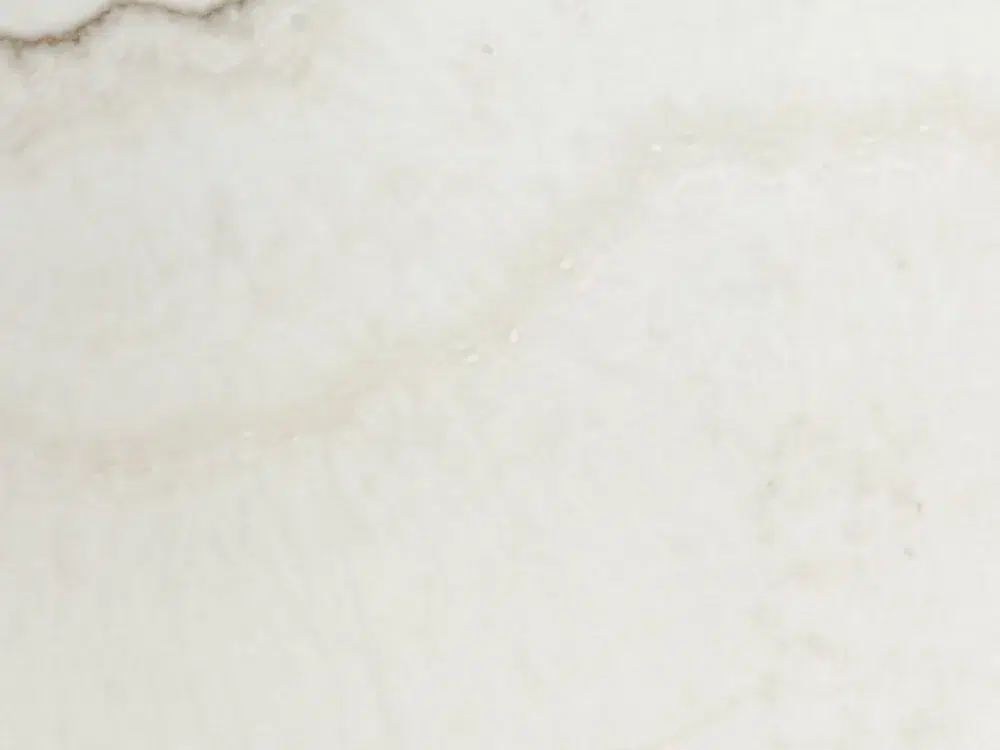-
Alessia Marble
Alessia MarbleAlessia Marble showcases a warm light salmon base, interwoven with brecciated segments in rich red and burgundy tones. Subtle pink salmon accents add depth and dimension, creating a visually dynamic surface with an inviting warmth. This marble’s organic composition and intricate patterning make it a striking choice for feature walls, statement countertops, or sophisticated flooring. Blending classic elegance with a bold, contemporary twist, Alessia Marble enhances interiors with a refined yet distinctive aesthetic.
-
Alpina Quartzite
Alpina QuartziteAlpina Quartzite is a soft grey blue stone with beautiful flowing veins running horizontally across the slabs, giving it a luxurious appearance. This quartzite comprises blue highlights as well as hints of green against the cool grey background. Aplina Quartzite creates a cool modern ambience that offers elegance to any space.
-
Altus Dolomite
Altus DolomiteThe Altus Dolomite seamlessly blends timeless hues with captivating patterns. Its pristine white and grey tones complement a wide range of modern designs, whether bold or understated. The Leathered finish adds a tactile dimension, enhancing the stone’s inherent natural blemishes. In any space, the Altus Dolomite radiates as a natural beauty, effortlessly enhancing its surroundings.
-
Arabescato Corchia Marble
Arabescato Corchia MarbleIntroducing Arabescato Corchia, an exquisite marble featuring black and grey veining with copper accents on an ivory background. The flowing veins create dynamic, organic patterns, making each slab a unique masterpiece of natural elegance. Ideal for luxurious countertops, elegant flooring, and striking wall features, Arabescato Corchia adds sophistication and versatility to both traditional and contemporary interiors.
-
Arabescato Gold Marble
Arabescato Gold MarbleArabescato Gold is a fusion of luxury and nature’s craftsmanship. It boasts a pristine white canvas adorned with unique veining, weaving together veins of gold, grey and copper. A timeless statement for your interior.
-
Arabescato Rosso Dolomite
Arabescato Rosso DolomiteArabescato Rosso Dolomite unveils its intricate complexity upon closer inspection. Harmoniously blending large white elements with veins of deep red and grey, this stone exudes a captivating balance. The natural interplay of tensions within its surface effortlessly captures the eye, while its Leather finish enhances both its visual allure and tactile appeal, creating a seamless fusion of texture and aesthetics.
-
Arabescato Vagli Marble
Arabescato Vagli MarbleArabescato Vagli, an epitome of refined elegance and stunning beauty that breathes life into any space it graces. Sourced from the picturesque quarries of Italy, this unique marble slab boasts a sophisticated white background accented by striking grey veins, a trademark of the arabescato vagli. This marble slab’s captivating aesthetics wonderfully blend with its innate robustness, providing both visual allure and practicality. The arabescato vagli marble slab harmonizes seamlessly with a wide range of design styles, rendering it a versatile choice for both residential and commercial interiors. The arabescato vagli marble slab’s mesmerizing patterns are also perfect for creating standout focal points, such as fireplace surrounds or statement walls, enriching your living space with an unmatched style statement.
-
Arabescato Verde Marble
Arabescato Verde MarbleArabescato Verde Marble showcases a white base with dramatic veining that weaves through the stone, accentuated by soft salmon pink tones. These warm accents bring a unique, inviting elegance to the surface, offering a fresh take on traditional marble. The stone’s dynamic veining and subtle colour palette make it a sophisticated choice for both modern and classic interiors. Perfect for statement countertops or striking feature walls, this marble introduces a refined warmth to any space.
-
Arcadia Quartzite
Arcadia QuartziteArcadia Quartzite is a rich natural stone that features colouration in deep green hues. The disctinctive patterns, naturally faceted appearance and striking veining make Arcadia Quartzite a perfect backdrop for an extravagant design.
-
Arctic Rain Dolomite
Arctic Rain DolomiteArctic Rain Dolomite is a striking natural stone. Cool grey white background with a myriad subtle white veining and dark blue central veins. Arctic Rain Dolomite is a timeless natural stone due to its colour tones and superior durability. Arctic Rain Dolomite is both dense and versatile, ideal for both commercial and residential applications. The unique patterning of this vibrant stone is balance of both dark and light elements. Available in a Honed and Leather finishes.
-
Arctic White Marble
Arctic White MarbleArctic White is an enduring natural stone that provides a premium yet subtle character to each application. Quarried in Greece, Arctic Marble is a balanced combination of dark grey veining against a crystalline white background make this stone perfect for a variety of internal wall and bench applications.
-
Ariana Gold Marble
Ariana Gold MarbleAriana Gold Marble is a beautiful natural stone that combines a clean-looking white background with delicate grey veining. Its appearance exudes elegance and sophistication, creating a serene ambiance in any interior space. Ariana Gold Marble is the perfect choice for those seeking a clean, timeless, and visually captivating marble for their interior design projects.
-
Ariana Marble
Ariana MarbleAriana Marble is an enduring natural stone that provides a premium yet subtle character to each application. Ariana Marble is a balanced combination of mottled pink and light grey veining against a stark white background. Hailing from the north of Greece, this white marble is available in a Honed finish and can also be ordered in a tile format.
-
Arielle Quartzite
Arielle QuartziteArielle Quartzite is a reminder of nature’s ability to produce wonderful and striking pieces of natural art. Arielle Quartzite is a spectacle of copper veins against the turquoise blue background, available in both a polished and leather finish. The unique pattern and large slab size of this stone makes it perfect for feature walls & oversized kitchen islands.
-
Arrakis Dolomite
Arrakis DolomiteThe Arrakis Dolomite effortlessly captures your gaze with its understated allure. Its cool white backdrop, subtly graced with veins of light grey, is punctuated by bold streaks of dark grey and gold, creating a striking contrast that commands attention with quiet confidence. With its versatile colour palette, Arrakis complements a wide range of residential and commercial settings. Available in a Honed finish, this exquisite Dolomite promises to be the focal point of any space.
-
Artemis Blue Quartzite
Artemis Blue QuartziteArtemis Blue Quartzite is a blend of the earth, air and sea; with earthy tones of brown, gold, green, grey and white. Artemis Blue Quartzite features a mixture of striking copper veining amongst a opaque blue grey base. A perfect natural artwork for those seeking an extravagant design.
-
Athena Marble
Athena MarbleAthena Marble is characterized by its beautiful shades of soft ash grey and dazzling gold veining throughout. Athena Marble is the perfect natural stone for creating a sense of luxury in the most exclusive of spaces. Athena Marble is a breathtaking natural stone with vibrancy and depth in a captivating composition. The radiant golden veining against the crisp white background is a delightful balance that is equally soothing, striking, and will not disappoint.
-
Atlantis Quartzite
Atlantis QuartziteAtlantis Quartzite is a durable, earthy tone stone from South America. The neutral grey background has dark angular veins through. Due to the stone’s quartzite composition Atlantis Quartzite is a durable and dynamic stone perfect for use in high use areas such as kitchen workbenches.
-
Augustus Grey Marble
Augustus Grey MarbleAugustus Grey Marble is luxurious marble quarried in Central Asia. This marble is a lavish and elegant blend of off-white earthy colour tones with minimal white veining. Augustus Grey evokes imagery of palatial lobbies, with an eye-catching high honed finish. The Augustus Grey Marble Slabs are complemented with matching tiles in Avant Stone’s Natural Stone Tile range.
-
Aurora Quartzite
Aurora QuartziteNamed after the vibrant polar lights, Aurora Quartzite is Nature’s artwork in its truest form. Aurora Quartzite has spectacular colorations of pastel green, grey and white. Aurora Quartzite is suitable for External and Internal applications due to its dense and durable structure. Aurora Quartzite will certainly make a statement to any application.
-
Austral Dream Dolomite
Austral Dream DolomiteAustral Dream Dolomite is a captivating natural stone that evokes a feeling of warmth and tranquility. Its soft hues of cream, adorned with delicate white and gold veining, create a sense of timeless elegance and understated luxury. This stone is perfect for spaces that aim to cultivate a serene and inviting atmosphere, whether in residential or commercial settings.
-
Austral Grey Dolomite
Austral Grey DolomiteAustral Grey Dolomite exudes elegance with its harmonious blend of warm grey tones, accentuated by sweeping charcoal and white veining. Thin gold and subtle salmon hues add refined highlights, lending an understated opulence to the stone. The diverse palette and natural movement across the slab create a captivating visual depth, making it an ideal choice for sophisticated interiors. Austral Grey Dolomite’s rich texture and warm colouration bring a modern, earthy charm to any space, whether used in feature walls, countertops, or flooring.
-
Azeroth Granite
Azeroth GraniteAzeroth Granite showcases a dramatic interplay of beige, soft greys, and deep charcoal mineral bursts across a richly textured surface. Its bold yet balanced palette makes it a striking choice for contemporary and transitional interiors alike. Ideal for kitchen benchtops, bathroom vanities, and feature walls, Azeroth delivers both visual impact and lasting durability. With its high resistance to heat and wear, this natural stone combines practicality with sophisticated design appeal.
-
Azure Sky Quartzite
Azure Sky QuartziteAzure Sky Quartzite is a breathtaking natural stone that enchants with its intricate veining and captivating colors. Its charcoal-grey and brown copper veins create a visually stimulating display that adds depth, movement, and intrigue to interior spaces. This stone is far from ordinary, boasting a beauty that elevates the aesthetic of any room.
-
Balerion Granite
Balerion GraniteThe Balerion Granite provides a strong foundation to any space. With its deep black backdrop adorned by swirling sand-brown patterns, it emanates the same robust resilience as the stone itself. Currently offered in a sleek Leather finish, Balerion Granite exudes a quiet yet authoritative presence, subtly asserting its enduring strength.
-
Bianco Bliss Marble
Bianco Bliss MarbleBianco Bliss Marble, a mixture of a soft white background and cloudy dark grey veining gives this stone a striking appearance without overpowering the space. This marble is utilised elegantly in a book-matched application allowing for the diagonal veining to create wonderful angular patterns.
-
Bianco Carioca Marble
Bianco Carioca MarbleBianco Carioca Marble is an exquisite natural stone that harmonizes intricate layers of dark grey veining, charcoal hues, and shades of white and grey. Its dynamic and captivating appearance adds depth and dimension to any interior design project, creating a visually striking statement piece.
-
Bianco Orobico Marble
Bianco Orobico MarbleBianco Orobico Marble is a compelling palette of grey swirls and veining against an off-white background. An eye-catching shimmer of light flows through this natural stone due to its beautiful crystallisations and translucent structure. Bianco Orobico Marble is suitable for interior applications, available in a Honed and Polished finish. The translucent composition of this wonderous Marble also makes it perfect for backlighting.
-
Bianco Quartzite
Bianco QuartziteBianco Quartzite is an off-white toned quartzite with soft veining that looks beautiful from all angles, creating a timeless elegant finish in any interior space. Bianco Quartzite is the perfect natural stone if you are seeking durability mixed with a classic natural finish. Bianco quartzite is stocked in a leather finish which accentuates the soft silver-grey veins throughout this stone.
-
Black Fusion Granite
Black Fusion GraniteBlack Fusion Granite captivates with its deep black base, dramatically contrasted by bold gold and white crystallized veining in a swirling, cloud-like pattern. The dynamic movement and rich tones add depth and sophistication, making it a striking choice for statement surfaces. Perfect for countertops, feature walls, and bold design accents, this granite brings a sense of luxury and refinement to both modern and classic interiors.
-
Blue De Savoy Marble
Blue De Savoy MarbleBlue De Savoy Marble, is opulent marble quarried in France. Characterised by its light grey veining against the grey/blue background, giving the stone its marbled appearance. Blue De Savoy is ideal for interior applications and can add a beautiful decorative appearance to any chosen space.
-
Blue Moon Granite
Blue Moon GraniteBlue Moon Granite is a striking stone with a grey and blue background and sharp angular veins which are completely unique to this stone. Blue Moon Granite is perfect for those seeking modern aesthetics in a durable natural stone. Blue Moon Granite is a particular favorite for use in external applications such as BBQ benches due to its rugged aesthetics and versatility. Blue Moon Granite is also available in tile & paving formats in the Avant Stone Natural Stone Tile range.
-
Breccia Anatolia Marble
Breccia Anatolia MarbleBreccia Anatolia Marble is a striking natural stone with a rich salmon-toned base, accented by bold brecciated red veining and delicate white streaks weaving throughout. This dynamic composition creates a sense of movement and depth, making it a compelling choice for statement interiors. Ideal for feature walls, benchtops, or bespoke installations, its warm hues and intricate patterns bring a refined yet dramatic touch to any space.
-
Breccia Bianco Marble
Breccia Bianco MarbleBreccia Bianco is a white grey marble with delicate spatters of charcoal, brown and gold. This material is similar to Arabescato Marble, however with significantly more patterning and movement. The unqiue patterning makes it perfect for those seeking an italian marble with a point of difference.
-
Breccia Damascata Marble
Breccia Damascata MarbleBreccia Damascata is a fusion of red, pink, and orange, adorned with captivating interplay of ivory veining, both thick and delicate. This exquisite marble promises to infuse warmth and sophistication into your interior, making it a standout choice for designers.
-
Breccia Rosso Marble
Breccia Rosso MarbleBreccia Rosso Marble known for intense burgundy patterning and hues of pink and gold. This bold Marble is suited for adventurous design applications. Breccia Rosso Marble is suitable for use in a honed or polished finish. This natural stone is fast becoming a favourite among the architecture and design community.
-
Bruno Perla Marble
Bruno Perla MarbleBruno Perla Marble a striking dark stone from Turkey. Characterised by its dark grey background and mixture of light and dark gold veining. A popular Marble due to its beautiful, veined appearance. Bruno Perla Marble is ideal for feature walls, bathrooms, and fireplaces. Bruno Perla is Marble that will stand out in any application, a great natural stone for classical and modern design applications.
-
Calacatta Monet Marble
Calacatta Monet MarbleA touch of elegance, Calacatta Monet. Featuring a warm white background, woven with luxurious veins of gold, red and purple. There’s no question, this luxurious Italian marble will make a statement in your home.
-
Calacatta Noir Marble
Calacatta Noir MarbleCalacatta Noir is a captivating symphony of contrasts. Its white canvas sets the stage for opulent veining, intertwining shades of gold, grey, copper, and black. Each slab of Calacatta Noir stands as a testament to nature’s masterful artistry, a true masterpiece that exudes grandeur and allure.
-
Calacatta Oro Marble
Calacatta Oro MarbleCalacatta Oro Marble is among the most sought-after marbles in the world. This Marble is quarried in the Carrara mountain ranges of central Italy. The pristine white background of this marble is contrasted with the bold warm grey veining. Calacatta Oro is one of the classic Italian white Marble, having been used on high-end luxury developments for centuries. The timeless nature of the color palette & magnificence of this stone leaves it as one of the most prized marbles in the Avant Stone range.
-
Calacatta Statuario Marble
Calacatta Statuario MarbleCalacatta Statuario marble, a distinctive material that personifies grace and elegance. Hand-selected from the choicest quarries of Italy, this exquisite marble, available at Avant Stone, is highly sought after by discerning homeowners, architects, and designers alike. The Calacatta Statuario marble is renowned for its crisp white background adorned with striking broad grey veins, an unparalleled blend of purity and drama that promises to transform any space into a vision of refined grandeur. Each slab is unique, embodying a timeless beauty that transcends the ephemeral trends, thus offering a sense of permanence and enduring appeal. Known for its exceptional versatility, the Calacatta Statuario marble is ideal for kitchens, bathrooms, fireplaces, and even accent walls, elegantly enhancing the ambiance of any setting with its remarkable aesthetic and superior quality. Despite its luxe appeal, the Calacatta Statuario marble is incredibly robust, balancing both functionality and aesthetics with effortless ease.
-
Calacatta Vagli Marble
Calacatta Vagli MarbleCalacatta Vagli Marble is a luxurious marble sourced from the Carrara Mountain ranges of Italy, characterised by its warm white background against the soft earthy-gold veining. A unique aspect of Calacatta Vagli is that it has a striking pattern for those looking to make a statement in large format applications, such as a kitchen island or feature wall, yet due to its brecciated pattern this stone also looks impactful in smaller segments such as shower niches or a fireplace hearth.
-
Calacatta Verde Marble
Calacatta Verde MarbleCalacatta Verde Marble is a cacophony of green, grey and gold veining against the beautiful white background. This visually striking feature stone is perfect for feature walls, kitchen islands and fireplaces. The heavy patterning of this Marble makes is perfect for use in both larger format such as a feature wall and smaller format such as a shower niche or vanities.
-
Calacatta Viola Marble
Calacatta Viola MarbleCalacatta Viola marble, a stone imbued with exclusivity and sophistication. Its mesmerizing white backdrop, juxtaposed with dramatic violet veining, gives it a grandiose aesthetic. Each Calacatta Viola slab is a testament to nature’s artistic prowess, and its durability adds value beyond mere appearance. Its versatility makes it a perfect statement piece, be it for your kitchen, bathroom, or living area. A testament to nature’s artistic mastery, it adds an aura of elegance and refinement to any space. It’s more than just owning a piece of stone; it’s about incorporating a piece of nature’s masterpiece into your lifestyle. Discover the luxury and class of the Calacatta Viola marble, where the essence of opulence takes form in an extraordinary stone.
-
Calamadro Grey Marble
Calamadro Grey MarbleCalamadro Grey, a beautiful dark grey marble from Central Asia. Characterised by the scattered white contrasting veins against the dark grey surface adds elegance and sophistication to any chosen space. Calamadro Grey is great for Interior walls, floors, splashbacks, and Island benches.
-
Calcite Blue Marble
Calcite Blue MarbleCalcite Blue Marble showcases a serene cool grey base, elevated by bold diagonal crystallized veining in a light blue hue. This distinctive pattern is further enhanced by subtle hints of green, offering a refreshing contrast. The unique interplay of colors and textures brings a sophisticated touch, ideal for modern interiors looking to balance elegance and tranquility. This marble’s cool undertones and dynamic veining make it an exceptional choice for high-end projects, where refined character and natural beauty come together.
-
Cappadocia Marble
Cappadocia MarbleCappadocia Marble is a rugged grey stone with copper veining. The grey background contrasted against striking rust veining is reminiscent of landscape touched by Lava. This sharp angular veined stone is perfect for large kitchen island, bathrooms or feature walls.
-
Caraxes Quartzite
Caraxes QuartziteThe Arrakis Dolomite effortlessly captures your gaze with its understated allure. Its cool white backdrop, subtly graced with veins of light grey, is punctuated by bold streaks of dark grey and gold, creating a striking contrast that commands attention with quiet confidence. With its versatile colour palette, Arrakis complements a wide range of residential and commercial settings. Available in a Honed finish, this exquisite Dolomite promises to be the focal point of any space.
-
Carrara C Marble
Carrara C MarbleCarrara C Marble, a white natural stone notable for its density and cool grey low contrasting veining. The quality of Carrara C is judged on the whiteness of the background and the definition of the veining. Carrara C is one of the most popular Marbles quarried in Carrara Mountain ranges of Italy. Carrara C Marble is a versatile stone which can be used for both classic and contemporary designs. Due to its white background and subtle patterning, there are a number of complimenting finishes that work well with this stone.
-
Carrara Extra Marble
Carrara Extra MarbleCarrara Extra Marble, a bright white marble that will bring a light, open feel to any application. A natural stone quarried in the famous Carrara Mountain ranges of Italy, it has been used extensively throughout famous monuments such as the Duomo in Florence. The extra in Carrara Extra Marble denotes the premium selection of this stone which has minimal veining and crisp white background. Carrara Extra Marble is the go-to White Marble choice for design professionals & homeowners due to its robustness.
-
Celestia Quartzite
Celestia QuartziteCelestia Quartzite is a true masterpiece of nature, showcasing hues of pastel green, grey, and white that come together in a harmonious and visually captivating composition. With its captivating colours complemented by dramatic white veining, Celestia Quartzite becomes an exquisite choice for interior designs that seek to incorporate the beauty and serenity of nature.
-
Cipollino Marble
Cipollino MarbleCipollino Marble has a deep dark background mixed with caramel and purple waves of colour giving this distinct natural stone its personality and its remarkable appearance. The bold coloring of this stone makes it perfect for those seeking a standout kitchen island or feature wall.
-
Classic Beige Travertine
Classic Beige TravertineFeaturing subtle bands of warm ivory, cream, and honey tones, Classic Beige Travertine brings a sense of calm and cohesion to any space. Its honed and filled finish delivers a refined matte texture, perfect for creating understated luxury in both residential and commercial environments.
-
Colonial White Granite
Colonial White GraniteColonial White Granite is a beautiful speckled natural stone. Characterised by its cream, white and burgundy spots, Colonial White is consistent with a subtle amount of character. The natural stone combines beautifully with different finishes, materials, and colour palettes. Offering seamless blends with lighter colours and an alluring contrast with darker colours..
-
Constantine Granite
Constantine GraniteConstantine Granite is a striking stone with a deep navy background with hues of brown and light grey sharp angular veins which are distinctive to this stone. Constantine Granite is the perfect stone for those seeking a contemporary finish. Constantine Granite is suitable for internal and external applications due to its versatility and durability. Constantine Granite is available in a Leather and Honed finish.
-
Copacabana Granite
Copacabana GraniteCopacabana Granite is a captivating natural stone that features thick black vein swirls against an ivory background, creating a busy yet visually stunning pattern. Its distinctive aesthetic adds drama, energy, and a sense of dynamism to any interior space. Despite its busy appearance, Copacabana Granite maintains a natural allure, making it a versatile choice for interior designs that seek to make a bold and captivating statement
-
Copenhagen Marble
Copenhagen MarbleCopenhagen Marble features stark white veining flowing against an intense black background offering a strong visual contrast throughout the stone. This Marble is infused with elegant movement and will make a statement in any chosen space.
-
Corteccia Quartzite
Corteccia QuartziteCorteccia Quartzite is an earthy ivory-beige stone with a natural, rustic charm. Its creamy base is enriched by bold, angular beige veining, interwoven with delicate touches of white and green. This organic pattern adds a sense of depth and movement, making Corteccia Quartzite a stunning choice for feature walls, countertops, or flooring. With its warm, grounded palette and dynamic veining, it brings a timeless elegance and natural texture that beautifully complements both traditional and contemporary interiors.
-
Cosmopolitan Quartzite
Cosmopolitan QuartziteCosmopolitan Quartzite, a stunning embodiment of opulence and charm in your interior design endeavors. A crystalline red quartzite, this exceptional stone exudes a captivating allure with its rich, deep red hues and intricate natural patterns. Its polished surface radiates a lustrous sheen, elevating any space with its vibrant and elegant presence. Ideal for benctops, flooring, and accent walls, Cosmopolitan Quartzite brings a touch of luxury to both residential and commercial settings. Its remarkable durability ensures long-lasting beauty, making it a timeless choice for those seeking to create a space that effortlessly combines boldness and sophistication.
-
Cote D’ Azur Marble
Cote D’ Azur MarbleCote D’Azur Marble is a constant head turner, one of the most dramatic and eye-catching stones in the Avant Stone Range. Cote D’Azur marble is a truly elegant stone which has a light grey background with dark grey quartz veining, and occasional hues of red, yellow and blue. This stunning Marble has been growing in popularity every year since its introduction. The dramatic details of this stone make it ideal for feature walls, kitchen islands and fireplaces.
-
Crema Perla Marble
Crema Perla MarbleCrema Perla Marble is a timeless blend of soft earthy tones in beige and white, accentuated by subtle veining in darker grey and white, adding depth and intrigue to your interior design. This marble embodies understated elegance, offering a versatile palette for creating sophisticated environments.
-
Crimson Rose Marble
Crimson Rose MarbleCrimson Rose Marble is characterised by its staggered veining which adds a natural texture and depth. Tones of burgundy, pink and gold blend this marble into a natural masterpiece. This bold stone is suited for adventurous design applications.
-
Cristallo Quartzite
Cristallo QuartziteIntroducing Cristallo Quartzite, a stunning stone sourced from Brazil. This quartzite boasts prominent brown veins against a unique blend of elegant beige and gray tones, with a subtle shimmer that reflects light beautifully. This stone can also be backlit.
-
Cristallo Rosa Quartzite
Cristallo Rosa QuartziteCristallo Rosa Quartzite embodies a harmonious blend of a delicate pink base with vibrant copper veining, offering a rich and dynamic aesthetic. The subtle crystalline texture combined with the bright copper accents infuses the space with warmth and sophistication. This striking natural stone provides an elegant focal point, perfect for creating luxurious surfaces in both modern and classic interiors.
-
Crystal White Quartzite
Crystal White QuartziteCrystal White quartzite is a mesmerizing natural stone that embodies the beauty of an icy glacier. Its pristine white hues are blended harmoniously, capable of commanding attention or gracefully complementing other design elements. With a timeless appeal and a distinctly modern identity, Crystal White quartzite brings a touch of sophistication and luxury to any interior design project.
-
Da Vinci Marble
Da Vinci MarbleDa Vinci Marble is an earth-toned masterpiece decorated with linear grey streaks and captivating variations in veining. With its blend of beige and black accents, this marble exudes sophistication, making it an ideal choice for elevating your interior design projects.
-
Damascus Dolomite
Damascus DolomiteDamascus Dolomite is a versatile choice for both residential and commercial spaces, effortlessly complementing diverse designs. Its light grey foundation reveals a rich history through delicate, angular black veining upon closer examination. With a refined Honed finish, this stone becomes a harmonious centrepiece, adding depth and character to any environment.
-
Diano Reale Marble
Diano Reale MarbleDiano Reale Marble is a sophisticated natural stone, characterized by its warm beige and soft ivory tones, delicately accented by flowing, organic veining. Subtle hints of gold and taupe weave through the surface, creating depth and movement. This elegant marble exudes warmth and timeless appeal, making it a versatile choice for luxurious interiors, from kitchen benchtops to serene feature walls.
-
Domus Grey Marble
Domus Grey MarbleDomus Grey Marble is an artistic blend of cool grey tones, subtle hints of blue, and delicate veining that weaves a timeless and serene aesthetic. Its subtle cloudy background and nuanced texture make it a versatile choice, effortlessly enhancing both minimalist and eclectic design preferences.
-
Emerante Quartzite
Emerante QuartziteEmerante Quartzite is an alluring natural stone. Known for its captivating emerald green background littered with dark contrasting veining. Due to its composition as a Quartzite, Emerante Quartzite is a durable and dense natural stone. Perfect for kitchen islands, benchtops, feature walls and bathrooms. Emerante Quartzite will add exquisite natural beauty to any application. Available in a polished finish.
-
Epoca Marble
Epoca MarbleEpoca Marble is a striking stone with an ivory-white base beautifully accented by cool grey veining, scattered throughout like delicate brush strokes in an abstract artwork. The balanced interplay of grey and white tones creates a high-movement pattern, giving the marble a dynamic yet refined presence. With its contemporary appeal and artistic texture, Epoca Marble is ideal for spaces that seek a bold statement, from feature walls and countertops to expansive flooring.
-
Fior Di Bosco Marble
Fior Di Bosco MarbleFior Di Bosco is a famous Italian marble characterised by charcoal grey background interwoven with fossils and silver white veining. Fior Di Bosco is a highly sought-after stone due to limited quarry production. The Fior Di Bosco Marble is stocked in a honed finish to accentuate the soft grey background colour of this wonderful stone.
-
Fior Di Pesco Marble
Fior Di Pesco MarbleFior Di Pesco Marble is a distinctive natural stone that combines earthy grey background tones with a striking white and pink veining. Fior Di Pesco Marble is a recent arrival to the Avant Stone range from the home of marble – Carrara, Italy. The striking veins make this stone perfect for large format applications such as oversized kitchen island and feature walls.
-
Four Seasons Quartzite
Four Seasons QuartziteFour Seasons Quartzite stands out with its vibrant blend of colours and textures. Soft blues, cool greys, and warm salmon tones form an intricate brecciated pattern that gives the surface movement and depth. The natural stone’s layered, fragmented mineral formations create dimension and character, making it a bold addition to any design.
-
Fusion Haze Quartzite
Fusion Haze QuartziteFusion Haze Quartzite features a subtle olive-toned base, accentuated by flowing white and grey veining that creates a striking sense of movement. Delicate copper veins weave through the surface, adding warmth and contrast to the intricate patterning. The stone’s dynamic composition makes it an ideal choice for statement countertops, dramatic feature walls, or luxurious flooring. With its bold yet refined aesthetic, Fusion Haze Quartzite transforms interiors with a balance of natural elegance and contemporary sophistication.
-
Fusion Quartzite
Fusion QuartziteFusion Quartzite is distinguished by its rich color palette and intricate patterns, exemplifying nature’s artistry. Deep grey hues are interwoven with accents of gold, beige, and olive, creating a dynamic and captivating visual effect. Its unique and versatile design makes Fusion an exceptional choice for adding sophistication and character to any space.
-
Fusion Red Quartzite
Fusion Red QuartziteFusion Red Quartzite is a distinctive natural stone, featuring a rich amber-red base interwoven with dynamic grey-blue veining in a mesmerizing swirl pattern. The organic movement of the veining enhances the depth of the stone, while subtle crystallization throughout adds a touch of brilliance. This rare quartzite’s bold yet refined aesthetic makes it an ideal choice for statement surfaces, effortlessly complementing both contemporary and classic interiorstemporary sophistication.
-
Galet Gris Marble
Galet Gris MarbleIntroducing our Galet Gris Marble! An elegant, brecciated stone featuring a palette of grey, charcoal and orange tones. This stone has seen increased interest in part due to return in popularity of Terrazo. The unique patterning of this stone makes it suitable for myriad of applications, from high end flooring applications to benchtop and wall applications.
-
Golden Spider Marble
Golden Spider MarbleGolden Spider Marble features a warm, white base, accentuated by angular gold veining and delicate hints of pink. The intricate, web-like veining creates a sense of depth and movement, while the harmonious blend of rich gold and subtle pink infuses the stone with warmth and sophistication, making it an ideal choice for any interior design style.
-
Grigio Carnico Marble
Grigio Carnico MarbleGrigio Carnico is an iconic Italian charcoal marble with heavy, cloudy white veins. Quarried in Northern Italy, this wonderful eye catching marble is perfect for feature walls, fireplaces, and indoors flooring. The extravagant veining of the Grigio Carnico marble make it suitable for appealing book-match applications.
-
Helicanus Marble
Helicanus MarbleHelicanus Marble is a refined yet bold material that brings depth and contrast to any interior. A cement-grey base serves as the foundation for intricate copper toned veining, enhanced by delicate white lines that traverse the stone. Warm copper and burgundy hues punctuate the surface, adding a bold yet balanced aesthetic.
-
Iceborne Quartzite
Iceborne QuartziteIceborne Quartzite presents a refined aesthetic, characterised by a soft grey, cloud-like base and a distinctive, organic veining pattern. Subtle hints of copper, olive, and blue add depth to its sophisticated palette. Ideal for kitchen benchtops, bathroom vanities, and feature walls, Icebourne Quartzite delivers a timeless yet unique statement in high-end interior design.
-
Indian Jet Black Granite
Indian Jet Black GraniteIndian Jet Black Granite, the deep dark stone with a magnificent polish. A timelessly classic Granite that will never look anything less than stunning due to its ultimate durability. Whether you want a traditional or modern look, Indian Jet Black Granite is one of the most versatile Granite options and you will certainly be able to create your desired look with this beautiful natural stone.
Read More
Black Granite Slabs are one of the most often utilized natural stones by property owners globally. Indian Jet Black Granite, with its natural black beauty and elegance, is at the forefront of the trend. In natural stones, Granite is renowned for its unparalleled toughness, durability, and beauty. Indian Jet Black Granite is a pitch-black background that exudes elegance and high-end style.
Why Choose Indian Jet Black Granite?
The aesthetics generated by incorporating Indian Jet Black Granite into your home décor or exteriors stand out like a sore thumb. This dark stone tends to make a modern, distinctive, and luxury design statement.
A large number of homeowners utilize this sophisticated Black Granite Slab in their kitchens and bathrooms to create a stunning impression. Even if you’re merely remodeling your kitchen, Indian Jet Black Granite may give it a unique flair. Another good reason to select Black Granite for a makeover is that it goes well with any color or texture of design components such as flooring, cabinets, and sink. Black is the most versatile color, blending well with a wide range of other hues. The black color complements other colors in your kitchen or bathroom decor. However, when paired with white or lighter islands and cabinets, The Indian Jet Black Granite creates a stunning visual contrast.
When it comes to Granite Slabs or tiles, the color and texture consistency given to any business or residential area is stunning. As a result, Indian Jet Black Granite may be utilized in various indoor and outdoor applications, depending on the individual’s preferences.
The polished surface of the Granite reflects the brilliance and emanates a sense of sumptuousness when used in a place illuminated by sunshine. The stone is a versatile material that you can use to create beautiful worktops, flooring, exterior cladding, and architectural elements.
Where Can You Use Indian Jet Black Granite?
Black Granite has the same or (in some circumstances) superior characteristics as other granite varieties. The stone is water and heat-resistant, and it requires very little upkeep. It may be readily sanitized by just wiping it down with soapy water. As a result, the stone can endure the test of time, even in subzero conditions.Bathroom
Indian Jet Black Granite would be the ideal choice for bathrooms. The stone is an excellent choice for bathrooms because it offers a prominent depth and a sense of refinement. Unfortunately, water, heat, and the humid atmosphere are all resistant to the stone.Kitchen Benchtops
Black Granite is a wise choice for a long-lasting and durable Benchtop that will look the same for years. A glossy black countertop gleams like a mirror, reflecting everything in its vicinity. Indian Jet Black Granite complements wood cabinets and light-colored design components beautifully. Another fantastic design concept is to pair the stone with stainless steel accents in the kitchen. The mix of steel grey and black gives it a classy look.Bar Tops
The stone is a fantastic material for customizing countertops and bar tops. In addition, because Granite is heat and scratch-resistant, Indian Jet Black Granite can be used in laundry rooms and kitchens as countertops. -
Infinity White Quartzite
Infinity White QuartziteThe grey background of Infinity White Quartzite serves as a neutral canvas, allowing the dark angular veining to take center stage. This versatile color choice seamlessly integrates with a variety of interior styles, from contemporary to traditional, adding a touch of timeless beauty and sophistication to the space.
-
Ivory Travertine
Ivory TravertineIvory Travertine exudes timeless elegance with its light beige base and refined vein-cut pattern, creating a seamless flow of clean, linear veins across the surface. Its soft, neutral tones offer a sense of warmth and sophistication, making it an ideal choice for contemporary and classic interiors alike.
-
Jurassic Black Marble
Jurassic Black MarbleJurassic Black, is a stone that will have you in awe with its incredible character. Jurassic Black possesses prominent grey and brown veining that protrude from the black background. Jurassic Black is the perfect stone if you are looking for sophistication, life, and movement! Perfect for feature walls and splashbacks, available in Honed, Leather, and Polished finish.
-
Lloret Marble
Lloret MarbleLloret Marble is a symphony of charcoal, grey and white tones with heavy movement but a uniform structure. This wonderfully versatile marble is appealing both in residential setting but also in commercial setting due to its sophisticated yet appealing appearance. Due to its continuous movement of veins throughout this stone it can be used in myriad of different applications.
-
Loki Limestone
Loki LimestoneLoki Limestone is beige/white stone available in multiples finishes such as honed and brushed & unfilled. Loki Limestone is a subtly patterned stone, perfect external applications such as cladding or pool coping.
-
Lucaria Marble
Lucaria MarbleLucaria Marble showcases an earthy latte-toned base, accentuated by bold, angular veins in olive green and black that strike diagonally across the surface. Light, scattered black veining adds a layer of complexity to the stone, enhancing its natural, grounded character. This Marble’s rich, organic colors and strong veining pattern make it an ideal choice for statement applications such as feature walls, fireplaces, and countertops. Lucaria Marble’s warm and earthy tones bring depth and texture to interiors, blending seamlessly with rustic, contemporary, or eclectic design styles.
-
Mirage Quartzite
Mirage QuartziteMirage Quartzite is a distinctive natural stone that combines earthy grey background tones with spectacular colourations of light grey and white. Ragged veining and heavy movement give this quarried stone its rugged aesthetics, while the striking visuals appeal to the sensibilities of both interior design professionals and homeowners.
-
Mithril Quartzite
Mithril QuartziteMithril Quartzite presents a dramatic interplay of bold and delicate white veins set against a deep charcoal grey backdrop. Accents of copper shimmer along the veining, adding warmth and depth to the cool, moody base. The striking diagonal lines are ideal for creating bold feature walls, benchtops and other statement pieces. Mithril Quartzite’s powerful contrast and organic pattern make it an exquisite choice for spaces seeking sophistication with a touch of modern edge, blending natural beauty with an upscale, luxurious appeal.
-
Mont Blanc Quartzite
Mont Blanc QuartziteMont Blanc Quartzite is perennial favourite of the Avant Stone natural stone range. Mont Blanc Quartzite is a perfect natural stone with its elegant marble like appearance but the wonderful durability of a Quartzite. Accented with soft grey and warm tan veining against the creamy white background, Mont Blanc Quartzite is ideal for benchtops, walls, and floors. The warm tone throughout the stone makes Mont Blanc Quartzite a fantastic match with timber finishes. Mont Blanc Quartzite slabs are also suitable in a book-matched application due to their angular veining.
-
Navona Travertine
Navona TravertineNavona travertine is a delicate and demure natural stone with a luminous white base, graced by creamy beige streaks, distinguishing it from conventional travertines. This natural stone, almost ivory in colour radiates a timeless charm that redefines sophistication for your space.
-
Nero Assoluto Granite
Nero Assoluto GraniteNero Assoluto is a deep black Granite that has a timeless look, whether used in a traditional or contemporary application. Nero Assoluto Granite is quarried in Zimbabwe, and is an extremely dense stone which offers a natural stain and heat resistance. Nero Assoluto is characterised by its dark colour and is available in the lightly textured leather finished, and medium textured pepper finish.
-
Nero Marquina Marble
Nero Marquina MarbleNero Marquina Marble is a high contrasting black Marble with delicate white veining against the deep dark background. Nero Marquina Marble is suitable for residential and commercial projects, particularly as a visually striking feature stone for large format applications such as fireplaces and feature walls.
-
New York Marble
New York MarbleNew York Marble a name bestowed to this beautiful marble for its heavy movement and striking visuals. Characterized by its sharp dark purple veining against the white background with hues of pink and purple tones. New York Marble Slabs are for those looking to really make a statement, a fact aided by the translucence of this stone which makes it perfect for Backlighting. New York Marble transforms into a magical vista when backlit, making it ideal for feature walls, kitchens, and commercial applications alike.
-
Obsidian Quartzite
Obsidian QuartziteObsidian Quartzite is a remarkably striking stone with a deep dark background mixed with warm gold and red quartz crystals that give this natural stone movement and personality. Obsidian Quartzite is a highly desired choice for kitchen benchtops due to its robust structure. Obsidian Quartzite is perfect for those seeking to make a statement with a remarkable feature wall or kitchen island. Available in a polished finish.
-
Ocean Blue Travertine
Ocean Blue TravertineOcean Blue Travertine, a sibling to Silver Travertine boasts a serene horizon of cool greys, silvers, and olive tones in a captivating horizontal pattern. Its neutral yet distinctive palette seamlessly complements a range of natural materials, offering versatility for kitchen benchtops, bathroom vanities, walls, floors and fireplaces.
-
Octavia Quartzite
Octavia QuartziteOctavia Quartzite is a subtle, calming natural stone. Consisting of light grey background, with contrasting deep grey striations. Octavia Quartzite is popular with many due to its striated appearance and subtle tones throughout which complement a number of finishes. Due to Octavia Quartzite’s geological composition, it is a dense and durable stone perfect for benchtops, flooring, and feature walls. Available in a leather finish.
-
Omega Black Quartzite
Omega Black QuartziteOmega Black Quartzite is a favourite among those seeking a dark coloured stone. The black background with the contrasting warm brown and white veining throughout give this natural stone a movement of its own. Not only is Omega Black Quartzite ideal for modern spaces, but it is also versatile & durable. This stone is often utilised in a leather finish, due to its unique properties which result in a deeply textured finish.
-
Palissandro Nuovo Marble
Palissandro Nuovo MarblePalissandro Nuovo features shades of neutral grey, white, gold and brown diagonal veining. Althrough from a far the stone has prominent veining, once the material’s grain is closely inspected the soft delicate patterning on this stone makes it quite unique.
-
Patagonia Blush Quartzite
Patagonia Blush QuartzitePatagonia Blush Quartzite is characterised by a light beige background adorned with standout pink crystallisation veining. Each slab showcases nature’s purest form of art, with the pink crystallisation adding a touch of allure to its overall appearance. Perfect for creating statement pieces in designs, Patagonia Blush Quartzite offers unparalleled beauty and versatility. Its ability to be backlit further enhances its appeal, allowing for the creation of mesmerising focal points that capture attention and elevate the ambiance of any space. Whether used as benchtops, feature walls, or backsplashes, Patagonia Blush Quartzite is sure to leave a lasting impression, transforming any space into a work of art.
-
Patagonia Noir Quartzite
Patagonia Noir QuartzitePatagonia Noir Quartzite is defined by its dramatic interplay of colour and texture, making it a captivating choice for high-end interiors. Its ivory-white base is cut through by angular veining, with one half displaying a rare crystallized white section, exuding depth and dimension. Accentuated by striking copper veins, this quartzite is a bold yet refined material, perfect for creating impactful design elements in any space.
-
Patagonia Quartzite
Patagonia QuartzitePatagonia Quartzite renowned for its stunning mix of colours and exceptional durability, this quartzite slab is an exquisite example of nature’s artistry. The Patagonia quartzite, sourced from the lap of Mother Nature, reflects a kaleidoscope of intricate patterns and hues, making every piece unique. The ethereal beauty of the slab embodies the chaotic harmony of Patagonia’s wilderness. The riveting display of vibrant veins on a muted background is reminiscent of the region’s dramatic landscapes. This quartzite slab brings an unmatchable blend of durability and aesthetics, offering resistance to heat and scratches while enhancing your spaces. A statement of luxury and strength, the Patagonia quartzite slab seamlessly bridges the gap between functionality and style. Choose this premium quality stone to experience a slice of the wild Patagonian landscape right in your home or office space.
-
Patagonia Retro Granite
Patagonia Retro GranitePatagonia Retro Granite showcases a stunning blend of warm beige, soft taupe, and cool grey tones, accentuated by bold white crystallisation. Its fractured patterns evoke the raw beauty of Patagonia’s landscapes, offering a unique and dramatic aesthetic. Renowned for its durability, this stone resists heat and scratches, making it a perfect fusion of strength and style – ideal for statement interiors that embrace natural elegance.
-
Pietra Grey Limestone
Pietra Grey LimestonePietra Grey Limestone is a beautiful contemporary natural stone quarried in central Asia. This limestone comprises of charcoal grey tones with prominent white veining throughout. Pietra Grey Limestone is a popular stone ideal for bathrooms, kitchens and living areas. Pietra Grey Limestone is an elegant stone choice for many design professionals due to the combination of minimalist veining and charcoal background which works with numerous other finishes such as timber and metal.
-
Pink Cristallo Quartzite
Pink Cristallo QuartzitePink Cristallo Quartzite showcases a stunning combination of delicate crystallization, a cloudy pink background, and scattered white veining. Its soft and inviting colors, along with hints of copper veining, create a mesmerizing visual display that adds a touch of sophistication to any interior space. Pink Cristallo Quartzite is a statement of refined luxury, providing a versatile and enduring natural stone option for a wide range of interior design projects.
-
Polaris Dolomite
Polaris DolomiteThe modern colour tones of Polaris Dolomite, with its cool grey palette, create a serene and timeless aesthetic. The subtle cloudy veining adds a touch of depth and visual interest, bringing a sense of movement and texture to the stone’s surface. Polaris Dolomite seamlessly integrates into any design scheme, whether you prefer a subdued and minimalist approach or a vibrant and eclectic style.
-
Portoro Quartzite
Portoro QuartzitePortoro Quartzite is a striking natural stone consisting of an intense black background with intersecting warm rust coloured veining and silver translucent crystals that give this stone a luxurious persona. The attractive patterns create high movement, and the distinctive veining can be incorporated into any design, from larger applications to unique detailed features that make a bold statement and stand out from the crowd.
-
Puglia Limestone
Puglia LimestonePuglia Limestone showcases a refined grey base accented by striking gold and copper veining, with subtle hints of red adding depth. Its unique colouration and organic movement make it a sophisticated choice for statement interiors.
-
Roman Classic Travertine
Roman Classic TravertineRoman Classic Travertine is renowned for its creamy white canvas adorned with delicate striations of warm beiges, transporting you to the heart of Rome’s architectural marvels. As the very essence of Travertine, it not only graces history’s grand structures but also bestows a smooth, expansive aura upon every space it adorns, a true testament to enduring beauty and heritage.
-
Roman Striato Travertine
Roman Striato TravertineStriato Roman Travertine is a premier Italian Travertine with an earthy warm background, grey horizontal veins and a unique structure present only in Travertine. Italian Travertine has a rich history as a building material, having been utilised in iconic monuments as the Colosseum. Striato Roman Travertine is quarried in the heart of the country, with many notable quarries in the outer regions of Rome. Striato Roman Travertine is available in vein cut, to accentuate the horizontal patterning of this unique stone and in both filled and unfilled finishes.
-
Rosa Noir Marble
Rosa Noir MarbleFeaturing a sophisticated blend of soft pink hues, bold black brecciated veining, and subtle green accents, Rosa Noir is a striking natural stone. Its captivating contrast and nuanced color palette make it ideal for luxurious countertops, flooring, and accent walls, adding a touch of timeless elegance to any space.
-
Rosso Levanto Marble
Rosso Levanto MarbleRosso Levanto Marble is an extravagant, gorgeous natural stone with deep burgundy background with segments of black and striking white veining. Rosso Levanto Marble was used primarily in traditional design contexts, however, it has made a comeback recently as the designers seek more colorful and unique stone pieces for contemporary projects.
-
Rosso Orobico Marble
Rosso Orobico MarbleLuxuriously hued deep red tone, Rosso Orobico Marble is distinguished by its waves of tawny sunset rose and dramatic range of white, black, burgundy, brown, red and grey tones. This uniquely patterned and richly patterned stone has been seamlessly blended by mother nature to create a bold statement masterpiece, perfect for those wishing to create an emphatic feature wall or feature kitchen island.
-
Rosso Travertine
Rosso TravertineRosso Travertine is a radiant standout in the world of natural stone. Its bold red hues and distinctive character make it a unique travertine choice, adding a vibrant and captivating element to your design.
-
Sahara Noir Marble
Sahara Noir MarbleSahara Noir Marble is another striking marble quarried in Central Asia. It is a combination of its deep golden, rustic, and white bold veining against the smooth black surface. Sahara Noir screams sophistication, and it is impossible to ignore its pure beauty. Sahara Noir is popular with designers in book-matched applications and adds striking elegance to every interior application.
-
Saint Tropez Dolomite
Saint Tropez DolomiteSaint Tropez is nestled within the earth’s embrace, emanates timeless elegance with its harmonious blend of gentle greys, soft whites, and subtle warmth of darker shades of grey. Delicate veins gracefully meander across its surface, whispering ancient stories etched in stone. Yet, it’s the accents of lightest, warmest blues that truly captivate, tracing the stone’s contours with ethereal grace, infusing it with tranquil movement and celestial allure. Each glance unveils new nuances, revealing the intertwined secrets of earth and sky, a masterpiece of nature waiting to adorn any space with its timeless grace and charm.
-
Scarlet Rose Quartzite
Scarlet Rose QuartziteScarlet Rose Quartzite makes a striking statement in any residential or commercial setting. Its expansive ruby sections are intertwined with delicate white-grey veins and scars, offering a captivating spectrum of hues across the surface. With its Honed finish, this stone infuses warmth and charm into any space it graces, inviting a sense of comfort and elegance.
-
Seashore Grey Quartzite
Seashore Grey QuartziteSeashore Grey Quartzite is a gracefully subtle Natural Stone. Characterised by its contrasting dark grey veining against the soft, warm olive grey background. Seashore Grey Quartzite offers a understated elegant pattern perfect for a subtle but impactful application. Seashore Grey Quartzite can create an elegant feel to any chosen space with the match of exceptional durability and performance.
-
Sierra Wave Granite
Sierra Wave GraniteSierra Wave Granite showcases a dynamic blend of silvery greys, charcoal tones, and soft creams, layered in sweeping, wave-like veining that flows elegantly across the slab. This natural movement creates depth and texture, making each piece truly one-of-a-kind. Flecks of white and hints of taupe add contrast and dimension, enhancing its visual appeal. Ideal for high-impact applications such as kitchen benchtops, feature walls, or bathroom vanities, Sierra Wave offers a bold yet refined statement in both contemporary and classic interiors.
-
Silver Cloud Marble
Silver Cloud MarbleSilver Cloud Marble is known for the clouded silver/grey veining against the light grey background. Silver Cloud is suitable for kitchens, bathrooms, walls, floors, and more. The smoky greys and hues of blue mix perfectly to create an angelic finish. Silver Cloud is a simply stunning stone with subtle and soft to touch in a beautiful, honed finish.
-
Silver Patagonia Quartzite
Silver Patagonia QuartzitePatagonia Silver Quartzite is a captivating natural stone defined by its crystalline structure and bold, expressive veining. A refined palette of silvers, soft greys, icy blues, and ivory whites creates a striking visual contrast, enhanced by areas of translucent mineralisation. With its dramatic composition and artistic movement, this quartzite is ideal for statement benchtops, feature walls, or high-end interior accents that demand attention.
-
Silver Root Marble
Silver Root MarbleDiscover the captivating beauty of Silver Root Marble, a unique stone with a cloudy grey backdrop, accented by bold, angular black veining for a contemporary and dynamic appeal. Whether used in kitchens, bathrooms, or living areas, Silver Root Marble infuses spaces with a refined and timeless charm.
-
Silver Sandscape Limestone
Silver Sandscape LimestoneSilver Sandscape Limestone is horizontal patterned earthy white and grey stone, with a warm tan toned background. Due to its linear patterning this natural stone is used extensively for wall and floor applications. The patterning of this beautiful Limestone makes it a great modern alternative to those looking for a light-coloured Travertine.
-
Silver Travertine
Silver TravertineSilver Travertine is a horizontal patterned natural stone featuring earthy white and grey nuances intertwined against a warm tan-toned backdrop. Its darker-hued grey striations offer a compelling contrast, rendering it an exquisite choice for extensive wall and floor applications, adding depth and allure to your design canvas.
-
Sky Fall Marble
Sky Fall MarbleSky Fall Marble is dark and mysterious just like its name. A combination of earthy white fine veins against the deep earthy grey background, and subtle even movement throughout is perfect for all types of application formats. A favourite among designers, the dark colour tone combined with a strong deep background colour, softer movement makes for an impressive contemporary look.
-
Super White Dolomite
Super White DolomiteSuper White Dolomite remains one of our ever-popular stone products largely due to its modern colour tones & superior durability. The arctic cool toned grey along with the contrasting grey veining throughout adds beautiful depth to the stone. No two blocks of Super White Dolomite possess the same beauty, they can be mottled or veined. Super White Dolomite is both dense and versatile, ideal for both commercial and residential spaces. Super White can be used in interior spaces for stone flooring, fireplaces, and other surroundings. Integrating with any design scheme, subdued or vibrant with its harmony of both light and dark elements.
-
Taj Mahal Quartzite
Taj Mahal QuartziteTaj Mahal Quartzite is an opulent Quartzite perfect for those seeking a sophisticated yet muted look. Taj Mahal has a distinctive appearance, characterised by its delicate warm beige crystal background and waves of warm orange and greys movement. This stone offers incredible versatility due to its dense crystal composition, making it extremely dense and durable. It is a great alternative for those wanting the look and feel of earthy Marble or Limestone, in a durable Quartzite.
-
Tempest Savoie Marble
Tempest Savoie MarbleTempest Savoie Marble is a natural stone with striated veining providing a strong contrast against its distinct blue-grey background. With flowing vertical and horizontal veins, this brooding stone is a must for those who want a moody and dramatic feature in their chosen application.
-
Thassos Gold Marble
Thassos Gold MarbleThassos Gold is a refined marble featuring a gentle ivory-white base adorned with soft, linear grey veining running horizontally across the surface. This elegant veining creates a calm and harmonious flow, perfect for spaces seeking a serene aesthetic. Distinctive touches of gold and copper accents intersperse the stone, adding a warm and luxurious depth to its appearance. Ideal for both residential and commercial interiors, from minimalist to classic.
-
Titanium Granite
Titanium GraniteTitanium Granite is a striking dark Granite with strong movement and patterning. Titanium Granite is known for its irregular sized white and gold crystallisations throughout the stone against an intense black background. Titanium Granite is bursting with elegant movement and will most definitely make a statement in any chosen space. Titanium Granite is stylish and durable, making it the perfect natural stone for exterior and interior applications.
Read More
If you want to give your kitchen or bathroom a vivid, elegant, or modern look, Titanium Granite Slabs could be just what you’re searching for. This stone naturally resembles the Galaxy but with milky white and gold moving throughout the stone, like satin against an intense black piece. The application of Titanium Granite is unrivaled.
Most homeowners are unaware that the benchtops they choose may make or break the overall appearance of the space. The choice of your benchtops has a significant impact on the value and usefulness of your kitchen or bathroom. This stone has long been a popular choice for countertops, but it’s also used in various other applications.
Flooring
Black flooring gives every room a sense of depth and intensity. Titanium Granite tiles or slabs on the flooring will enhance the aesthetics while providing the area a traditional appeal. Stone specialists recommend Black Granite Floor Tiles for spaces with lots of natural light.Accent Walls
Without any effort, just using Titanium Granite on accent walls may give even the most basic home décor a wow factor. This stone can be utilized as a feature wall in bathrooms or behind a shower or a bathtub. It may also be used as a backdrop for walls in living rooms or kitchens.Outdoor Cladding
Titanium Granite will be a unique choice for wall cladding because it catches the light and reflects it brilliantly. It’s also a better choice than other stones since it can withstand sunshine, dust, and water without losing its quality or appearance.Why Choose Titanium Granite?
The flexibility of Granite is one of the significant reasons for its popularity. In addition, titanium Granite Countertops may help homeowners establish various interior design themes by tying the whole appearance of their kitchen or bathroom together. So, whether you’re going for a modern look, a more traditional look, or even a vintage look for these areas, the gorgeous aesthetic of Titanium Granite Benchtops is sure to match with whichever designs you have in mind.Besides the versatility of Titanium Granite, the stone is a magnificent choice for high-traffic applications such as kitchens. They’re tough, long-lasting, and resistant. Granite is produced as an igneous rock under tremendous temperatures and pressure, resulting in an extremely durable material, heat and fire-resistant.
One more advantage of Black Granite Countertops is that they don’t require much cleaning as lighter-toned table top materials. As you might expect, the surface does an excellent job of concealing darker stains. Without a doubt, this makes Black Granite the ideal benchtop material for homeowners seeking a long-lasting and profitable investment to enhance their space’s aesthetic appeal, practicality, and it’s a lot easier to keep up with.For these three reasons and more, Titanium Granite Countertops are a classic choice for your kitchen or bathroom. First, they’re made of natural stone, which is a very trendy feature among new homeowners these days. It is due to the material’s inherent beauty and distinctive appearance and its unrivaled strength and longevity. Second, black is a timeless color that will never go out of style, regardless of the trends that come and go throughout the years. So go ahead and contact us, Avant Stone, to buy this gorgeous stone.
-
Titanium Grey Marble
Titanium Grey MarbleTitanium Grey Marble a striking stone that makes a statement in any application. A mixture of bold copper veins, against the dark grey background, Titanium Grey Marble is available in large slabs ideal for feature walls, bathrooms, kitchens and living room applications. The copper veining of the Titanium Grey Marble makes it particularly versatile with metal and timber accents.
-
Travertine Grigio
Travertine GrigioTravertine Grigio is a travertine that features a pale, neutral base color with darker, distinctive lines running across its surface. The striations, or bands, are typically a shade or two darker than the background color, creating a subtle yet striking contrast. Grigio travertine is known for its versatility, making it a popular choice for both indoor and outdoor applications, such as flooring and wall cladding.
-
Tundra Grey Limestone
Tundra Grey LimestoneTundra Grey Limestone. The elegant soft tones of this natural stone make it ideal for giving a delicate, yet high-end feel to any application. The ability of this beautiful stone to match with most materials and finishes makes it a perfect long-term décor choice. Tundra Grey is quarried in Turkey and is a densely patterned limestone of light grey and whites. It is available in both tile and slab formats, making it suitable for myriad design applications.
-
Turco Argento Limestone
Turco Argento LimestoneTurco Argento has elegant soft tones throughout this natural stone. Turco Argento is a Limestone that gives a high-end feel to any chosen space. Turco Argento has the ability to compliment most materials and finishes. Turco Argento has a timeless effect on any application, making it the perfect décor choice. Turco Argento is a densely patterned natural stone with added warmth making it suitable for those lookng to create calming, homely feel.
-
Valinor Quartzite
Valinor QuartziteValinor Quartzite is a captivating natural stone, showcasing a fusion of jade green, deep black, and crisp white tones. Its complex veining creates a dynamic sense of movement and depth, adding visual intrigue to any space. A bold yet refined selection, this quartzite makes a powerful statement, enhancing both contemporary and traditional interiors with its distinctive character.
-
Vena Roha Marble
Vena Roha MarbleVena Roha is an opulent and elegant stone with a sharp white background covered in dark red tinged veins. This stone has hues of deep pink, red and orange and is known for its high luster and timeless look.
-
Verdant Limestone
Verdant LimestoneVerdant Limestone is a graceful composition featuring a soft grey base and delicate, swirling veins of light white. This limestone brings a sense of serenity and sophistication to interior spaces, offering a canvas of timeless elegance for designers.
-
Verde Alpi Marble
Verde Alpi MarbleVerde Alpi Marble is a luxurious emerald green stone, with hues of white and dark green. A favourite of interior designers due to the opulence and vibrancy it brings to any application. The captivating colours and brecciated veining combined resembles an aerial shot of a swirling ocean. Verde Alpi Marble will make a statement in any chosen space!
-
Verde Oceania Marble
Verde Oceania MarbleVerde Oceania Marble captivates with a palette of green and grey hues set against an off-white backdrop, adorned with linear dark veining. Its crystalline structure allows light to glimmer upon its surface. This distinctive statement piece effortlessly brings the essence of natural elements into any design.
-
Verde Olympus Marble
Verde Olympus MarbleVerde Olympus features a deep intense dark green background, intersected by horizontal, diagonal and dramatic vertical veining. This Grecian beauty is perfect for those seeking a deep dark green colour with heavily contrasted angular veins .
-
Vhagar Quartzite
Vhagar QuartziteVhagar Quartzite is a remarkable natural stone characterized by flowing hues of olive greens and gold, and adorned with earthy tones. This stone’s organic-inspired patterns and captivating colours bring the beauty of nature indoors, creating a visually captivating environment.
-
Vintage Grey Limestone
Vintage Grey LimestoneAccented with a scattering of delicate white veining, Vintage Grey has a contemporary design that offers elegance to any space. A great long term choice for modern open-plan living spaces, this limestone is incredibly versatile and presents a crisp cool grey design.
-
Viscount White Granite
Viscount White GraniteWonderous Viscount White Granite, this natural stone would not look out of place in a stately home or palace. Characterised by its bold, elegant movement against the cool grey surface. Due to its granite composition, Viscount White is renowned for its heat resistant, durability and versatility. Viscount White is easy to clean, maintain and is completely timeless in its appearance.
-
Vittoria Reggia Quartzite
Vittoria Reggia QuartziteExperience the sophistication of Vittoria Reggia Quartzite, distinguished by its deep smoky green tones and intricate swirling veining. The interplay of bold dark veins and a leathered texture creates a dynamic and captivating visual effect. Ideal for high-end interiors, this quartzite offers both uniqueness and versatility, enhancing any design with its presence.
-
Volakas Azure Marble
Volakas Azure MarbleVolakas Azure Marble is a true embodiment of elegance with its distinctive features. The thick ribbons of grey and gold create a sense of movement and drama, adding depth and visual interest to the marble’s alabaster white backdrop. The contrasting colors create a mesmerizing interplay that catches the eye and becomes a focal point of any space.
-
Volakas Marble
Volakas MarbleVolakas Marble is distinguished by its thick ribbons of silver flowing through the alabaster white following a linear diagonal motion. This unique, elegant natural stone, which is available in a honed finish is equally at home in both classic and contemporary settings.
-
Vulcan Quartzite
Vulcan QuartziteVulcan Quartzite has a unique assortment of colour with a compilation of intense strains of reds, browns and deep blues with delicate waves of warm gold copper veining that glints like gold in the light. Perfect for those wishing to create a bold feature wall or kitchen island with a character of glamor and sophistication.
-
White Macaubas Quartzite
White Macaubas QuartziteWhite Macaubus Quartzite enchants with its pale white base color and delicate veining that gracefully meanders across the slab. The gentle veins create a subtle yet mesmerizing pattern, adding depth and character to the stone’s surface. Complemented by a soft gradient of earthy colors, White Macaubus Quartzite brings a sense of warmth and natural allure to any interior design project.
-
White Onyx
White OnyxWhite Onyx is a premium luxury stone renowned for its refined elegance and timeless appeal. Characterised by a luminous white base with soft beige undertones, this exquisite material brings a sense of warmth and depth to any space. Subtle, flowing veining enhances its ethereal, cloud-like appearance, making it an ideal choice for benchtops, feature walls and vanities, the perfect choice for high-end interiors seeking to make a bold yet graceful design statement.
-
Zebrano Quartzite
Zebrano QuartziteZebrano Quartzite comprises of a base of white and grey, with thick black veins flowing across the surface in waves. This Quartzite adds a visually interesting look with its distinct and varied shades of colour, creating a stunning and dynamic effect whilst still maintaining its natural look. Available in Leather.
Natural Stone Slabs
Embracing the timeless beauty and unparalleled durability of natural stone slabs can transform any space into a masterpiece of design and functionality. From the subtle elegance of marble to the robust resilience of granite, natural stone slabs offer a versatile and sustainable solution for enhancing both residential and commercial spaces.
Why Choose Natural Stone Slabs?
For many reasons, natural stone slabs stand out as a much better option than any other materials to use for construction or renovation. The combination of their natural beauty, longevity, and singularity make them a favorite among architects, designers, and homeowners. Here are some compelling reasons to choose natural stone slabs for your next project:
- Timeless Beauty: Natural stone slabs, with their unique patterns and colours, bring an unmatched aesthetic appeal to any space. Unlike manufactured materials, they possess a natural charm that adds a touch of elegance and sophistication.
- Durability and Longevity: The durability of natural stone is among its major advantages. They can tolerate severe abuses from users and harsh environmental conditions in order to last year after year and remain appealing.
- Unique Character: Each natural stone slab is one-of-a-kind. This means your design will always be unique, setting your space apart with its individuality and exclusivity.
- Adds Value: Implementing natural stone in a building project often increases the property’s value. It’s a sought-after feature in real estate, making it a wise investment choice.
Types of Natural Stone Slabs
Natural stone slabs have been widely used as flooring, countertops, and other materials. The materials offer a one-of-a-kind look and strength not provided by any other material. Nevertheless, not all natural stone slabs are equal. There are different types of natural stone slabs, each with its own characteristics, advantages:
Marble Slabs
Marble, is known for its distinctive veining and lustrous finish. Ideal for creating a statement piece, marble slabs add a touch of elegance to any setting.
Granite Slabs
known for its toughness and diversity in colors, granite is a practical choice for high-traffic areas. Its durability and heat resistance make it perfect for kitchen countertops and floors.
Quartzite Slabs
Quartzite offers a unique blend of marble’s beauty and granite’s strength. Its crystal-like appearance and remarkable resilience make it suitable for a variety of applications.
Dolomite Slabs
Dolomite, often compared to marble and quartzite, stands out with its durability and striking visual appeal. Its resistance to etching and stains makes it a popular choice for kitchens and bathrooms.
Limestone Slabs
Limestone is prized for its earthy tones and natural, textured finish. Perfect for creating a warm, inviting atmosphere, it’s often used in outdoor applications.
Travertine Slabs
Travertine, with its distinct pitted holes and troughs, offers a rustic yet sophisticated look. It’s a versatile material used in both indoor and outdoor spaces.
Applications of Natural Stone Slabs
Natural stone slabs are not just about aesthetics; they also offer functional versatility, making them suitable for various applications. From kitchen countertops to outdoor patios, the use of natural stone can transform any space. Let’s explore the diverse applications of these beautiful slabs.
- Countertops and Benchtops: Natural stone slabs are ideal for creating stunning kitchen and bathroom countertops. Their durability and resistance to heat make them perfect for these high-use areas.
- Flooring: Stone slabs provide a durable and luxurious flooring option. Whether in a residential living room or a commercial lobby, they add a touch of elegance and can handle heavy foot traffic.
- Stone Wall and Splashbacks: As wall, natural stone brings texture and depth to interior and exterior walls. In kitchens, stone splashbacks are both functional and visually appealing.
- Feature Fireplaces and Mantels: A fireplace surrounded by natural stone stands as a focal point in any room, exuding warmth and style.
How to Choose the Right Natural Stone Slab for Your Space
Selecting the right natural stone slab can be a daunting task, given the array of choices available. It’s about finding the perfect balance between aesthetics, functionality, and maintenance. Here are key considerations to help you make an informed decision.
- Assess the Aesthetic and Color Scheme: Consider the overall design theme of your space. The stone should complement existing elements such as cabinets, walls, and furniture.
- Understand Stone Properties: Research the characteristics of different stones. Some, like granite, are more suited for high-traffic areas, while marble offers unparalleled elegance but may require more care.
- Consider Lifestyle and Usage: Think about the practical aspects of your space. For busy kitchens, stain-resistant and low-maintenance stones are preferable.
- Budget Considerations: Factor in both the cost of the stone and the installation. High-quality stones like marble and granite are more expensive but offer longevity.
- Seek Expert Advice: Consulting with a stone specialist or interior designer can provide valuable insights into the best type of stone for your project.
How to Care & Maintain Your Natural Stone Slabs
Caring for natural stone slabs is essential for maintaining their beauty and longevity. Given their natural origin, these slabs have unique characteristics that require specific maintenance practices. Proper upkeep not only preserves the aesthetic appeal of the stone but also ensures it remains a durable and functional part of your space for years to come.
- Routine Cleaning with Gentle Products: To maintain the pristine look of your stone slabs, regular cleaning with gentle, non-acidic products is vital. Use a soft cloth or sponge, along with a mild detergent or stone cleaner, to wipe the surface. This prevents the accumulation of dirt and grime without damaging the stone’s natural finish. Avoid using harsh chemicals, vinegar, or lemon juice, as these can etch the surface, especially on softer stones like marble.
- Immediate Attention to Spills and Stains: Natural stone, particularly porous varieties like marble and limestone, can absorb spills, leading to stains. It’s crucial to blot any spillages immediately with a soft cloth. For oil-based stains, a mixture of baking soda and water can be used as a poultice to draw out the stain. However, it’s important to test this on a small, inconspicuous area first to ensure it doesn’t harm the stone.
- Regular Sealing for Protection: Many natural stone surfaces, especially in high-use areas like kitchens and bathrooms, benefit from regular sealing. Sealants provide a protective barrier against staining and water damage. The frequency of sealing depends on the type of stone and the level of use; some stones may require sealing once a year, while others may need it more frequently.
- Use of Trivets and Coasters: Protect your stone surfaces from potential damage by using trivets under hot cookware and coasters under beverages. This is particularly important for marble and limestone, which can be sensitive to heat and prone to etching from acidic substances.
- Avoiding Abrasive Tools and Scouring Pads: Scrubbing your stone slabs with abrasive tools can scratch and dull the surface. Instead, opt for softer cleaning cloths or sponges. For tougher stains, use a stone-specific cleaning product and gently work on the stain with a soft brush.
Frequently Asked Questions (FAQs)
What are the Advantages of Using Natural Stone Slabs?
Natural stone slabs offer unmatched durability and timeless beauty, elevating any space with their unique patterns and textures. These slabs are incredibly versatile, fitting various design aesthetics, and are eco-friendly, being a natural, sustainable resource. Additionally, they add significant value to properties, making them a wise investment.
Can I Customize the Size and Shape of Natural Stone Slabs?
Yes, natural stone slabs can be customized in size and shape to suit specific design requirements. This flexibility allows for unique and tailored applications, whether for countertops, flooring, or decorative features. Professional stonecutters can precisely shape and size the slabs to fit your exact specifications.
How Do I Care for and Maintain My Natural Stone Slabs?
Caring for natural stone slabs involves regular cleaning with pH-neutral cleaners and prompt spill management to avoid stains. Periodic sealing is recommended to protect porous stones. Avoid abrasive cleaning tools and harsh chemicals, and use coasters and trivets to prevent etching and heat damage.

